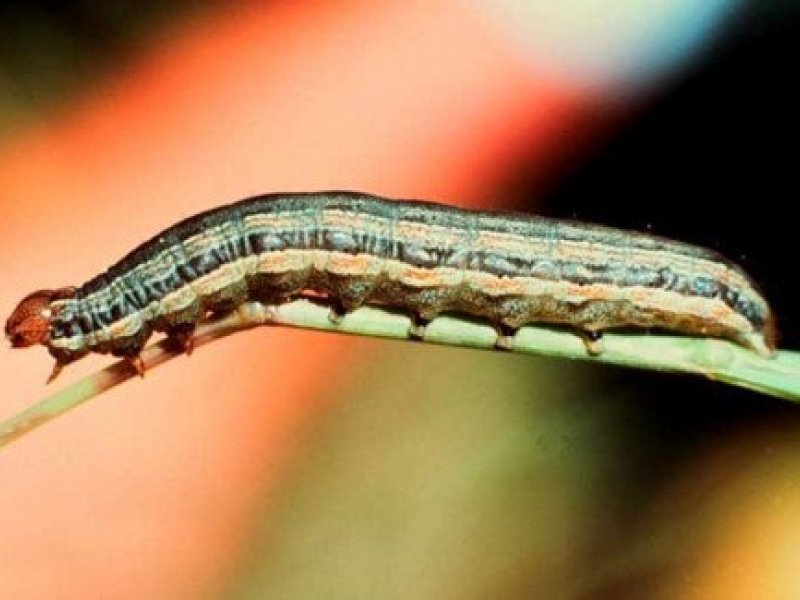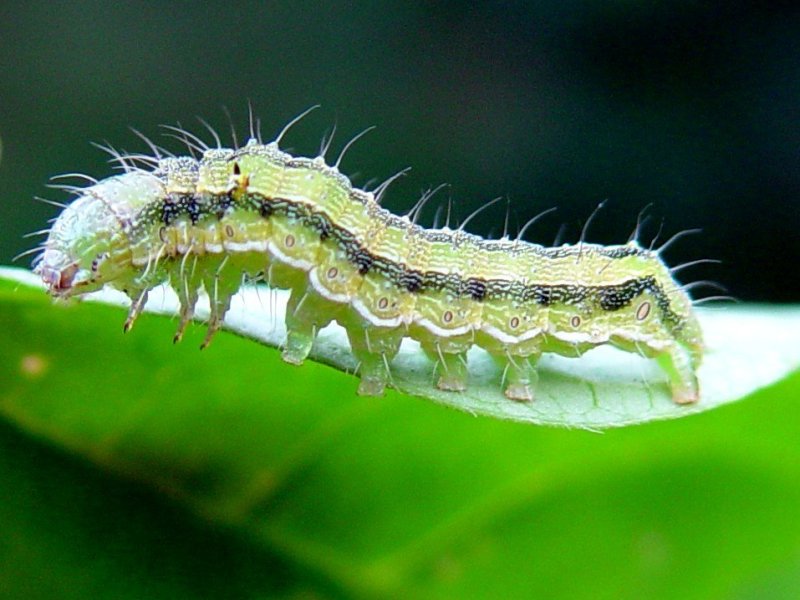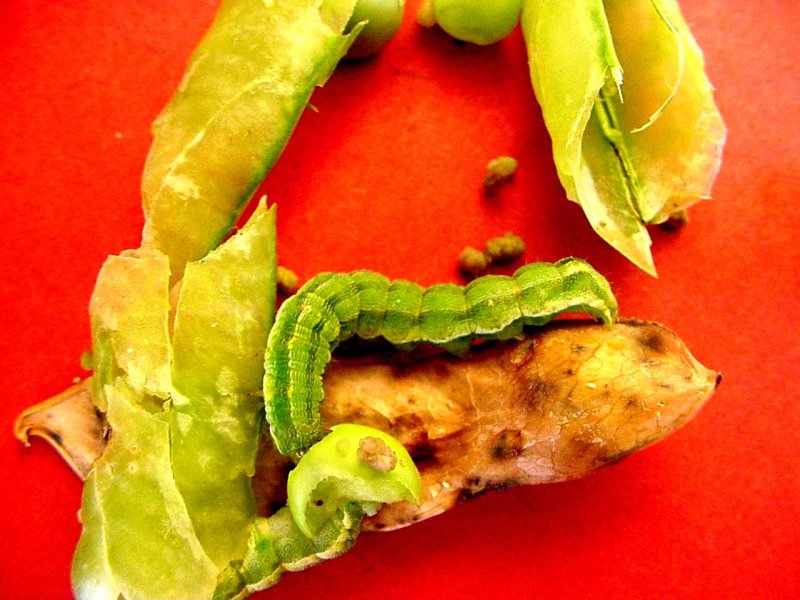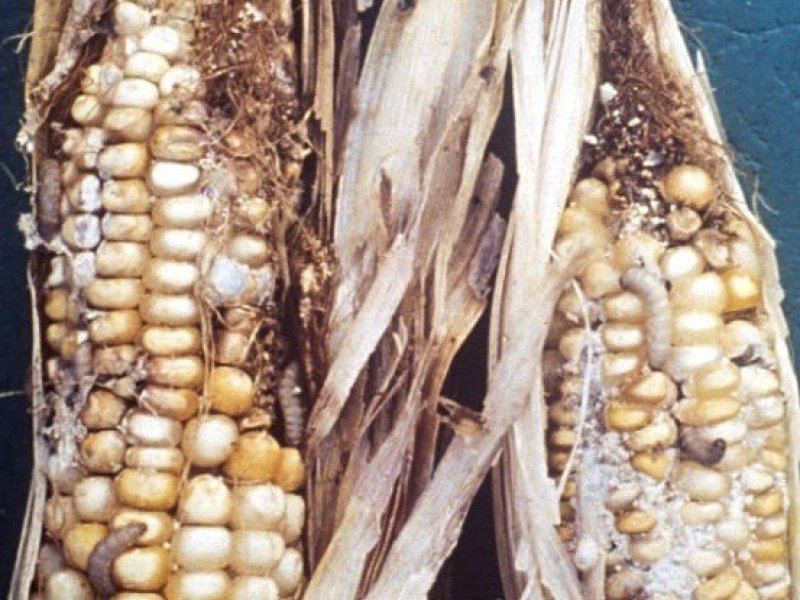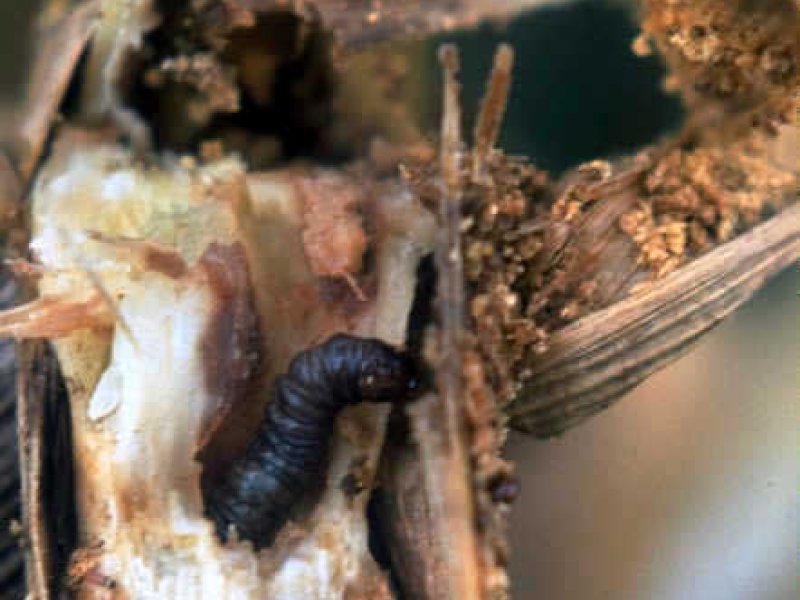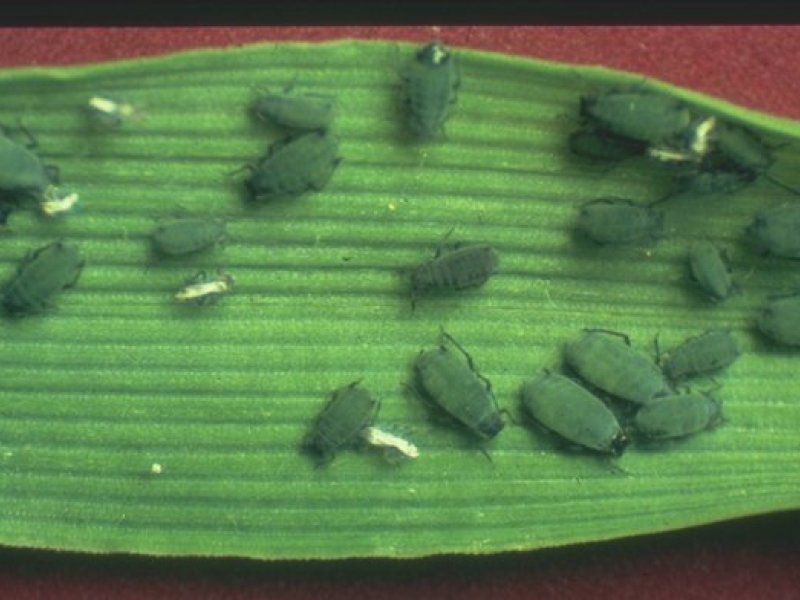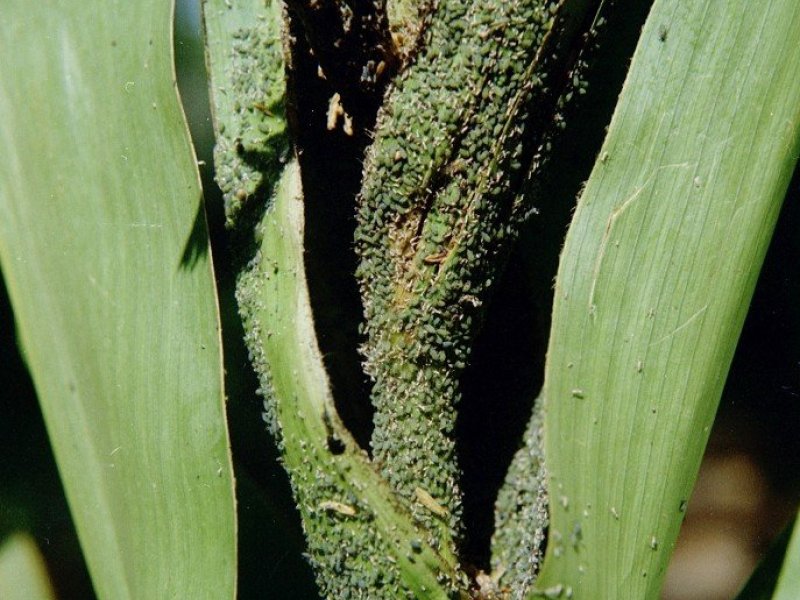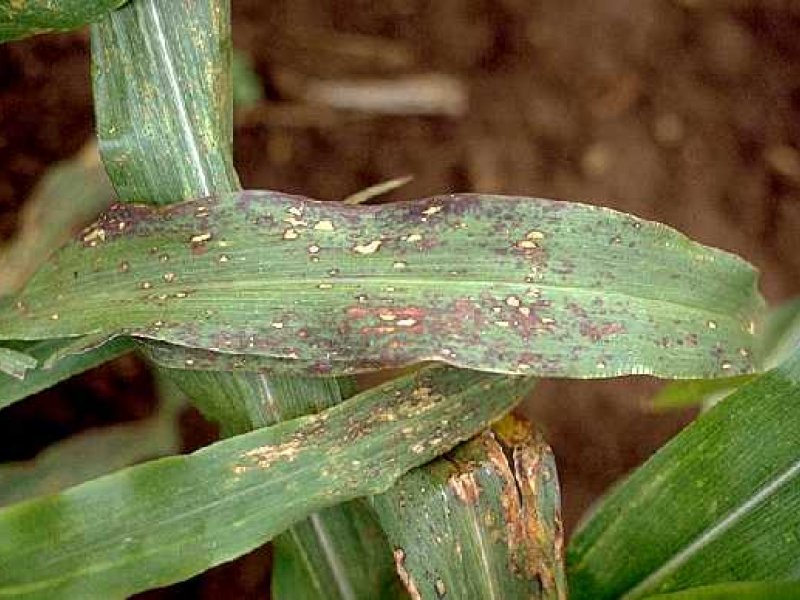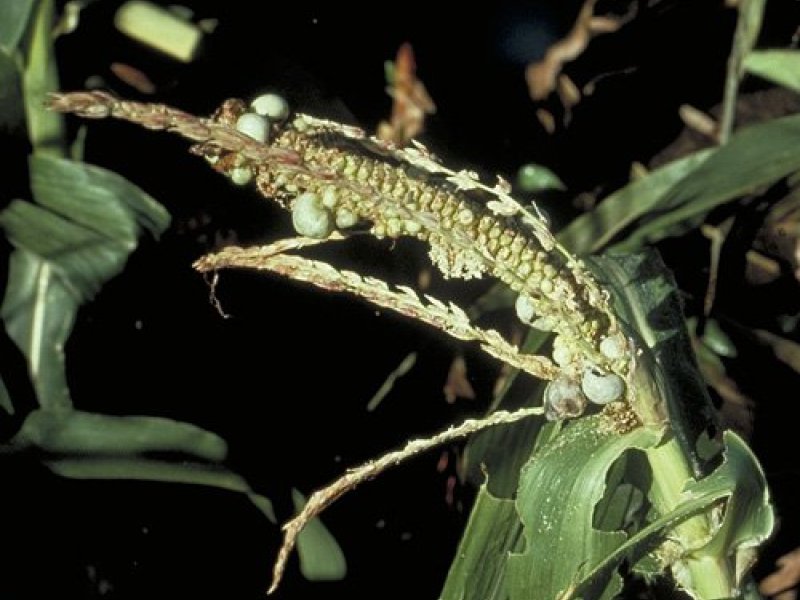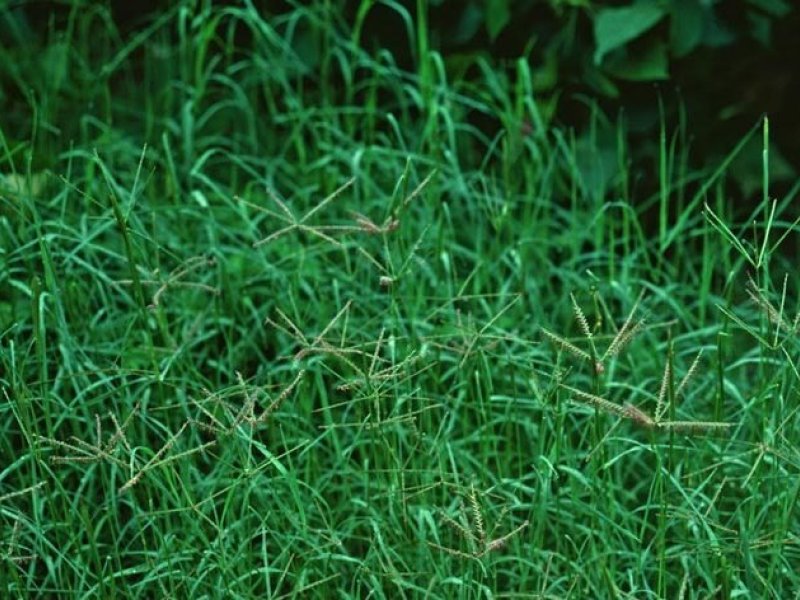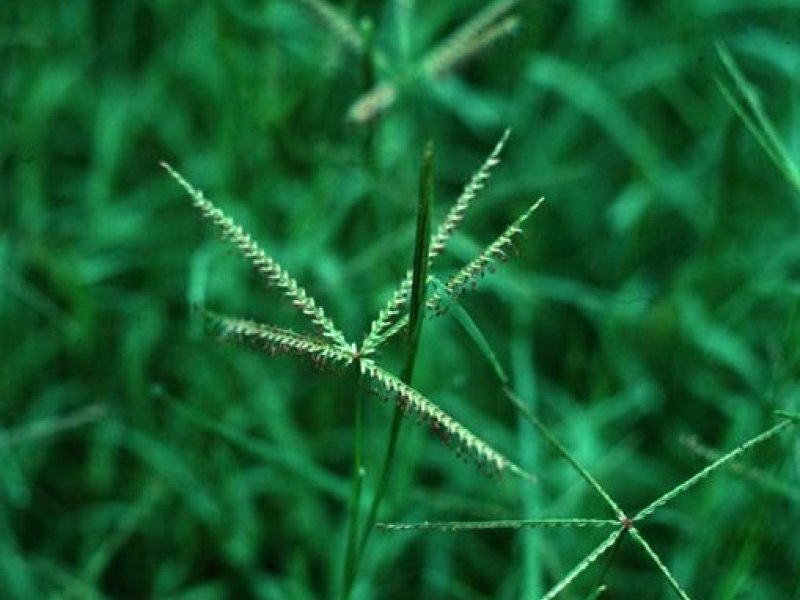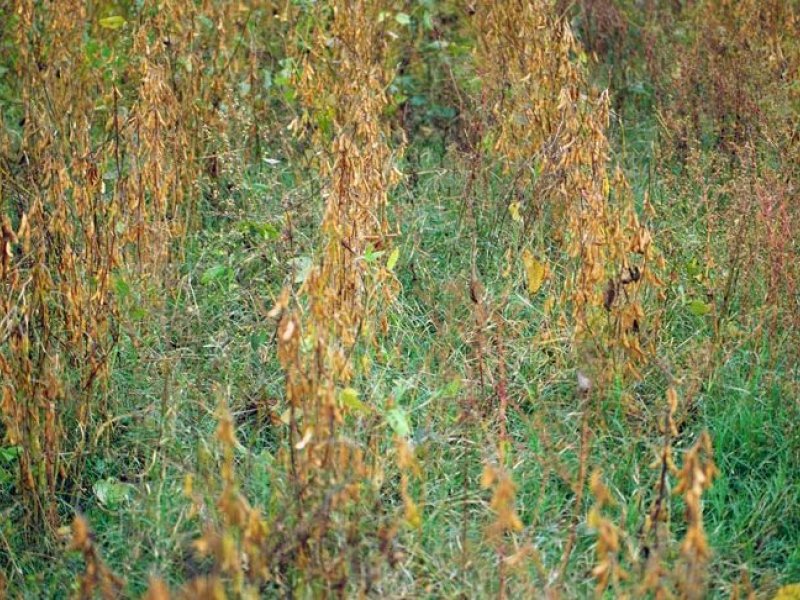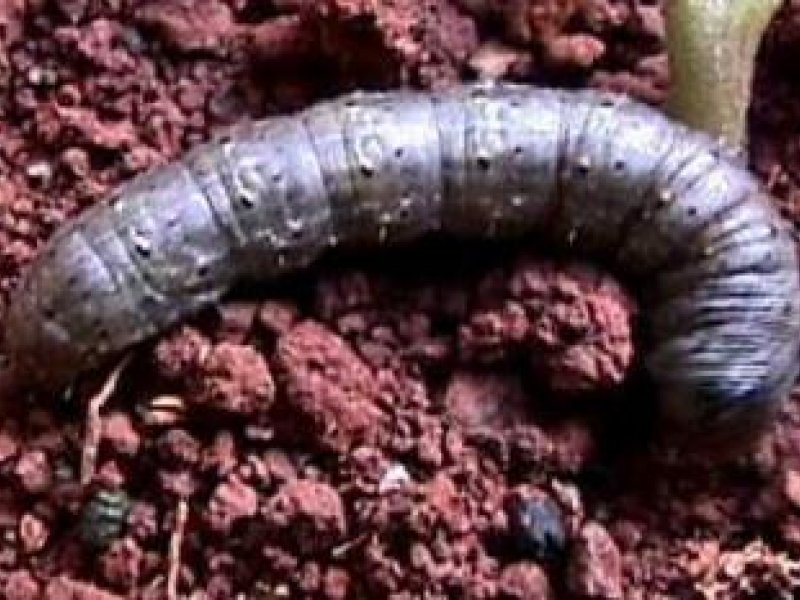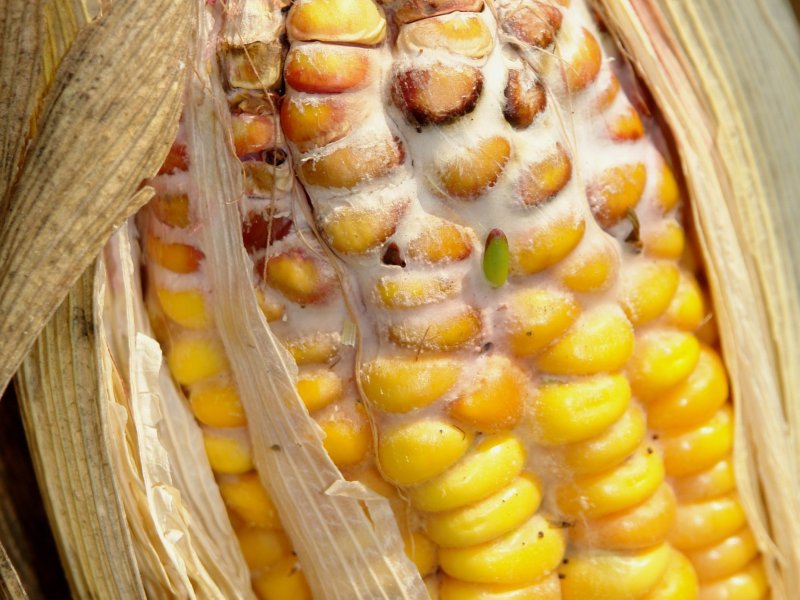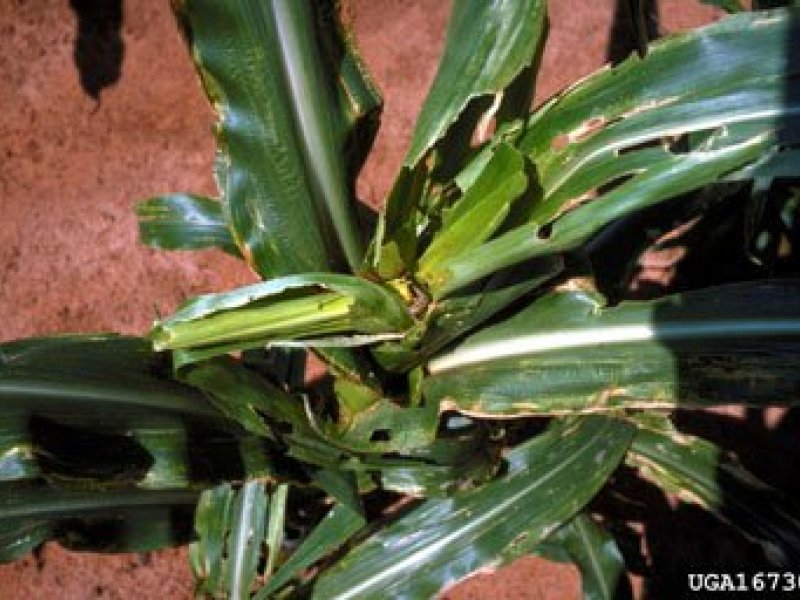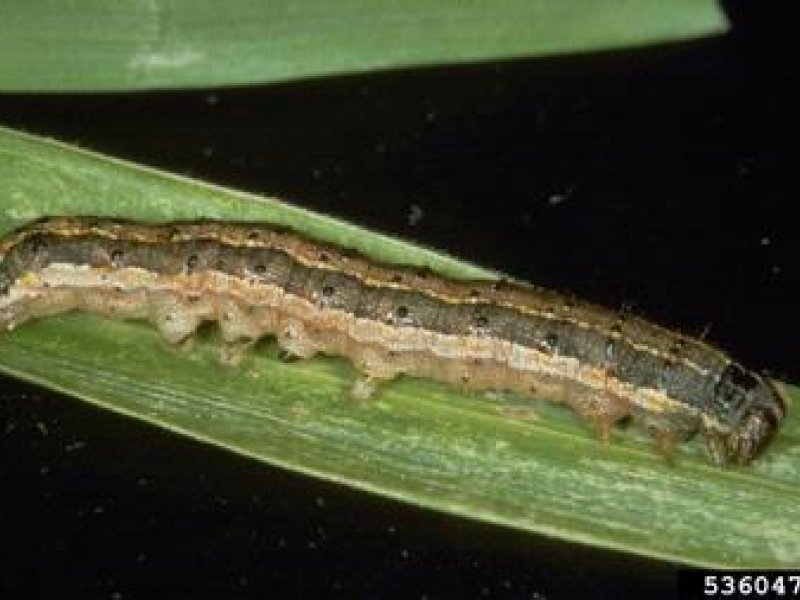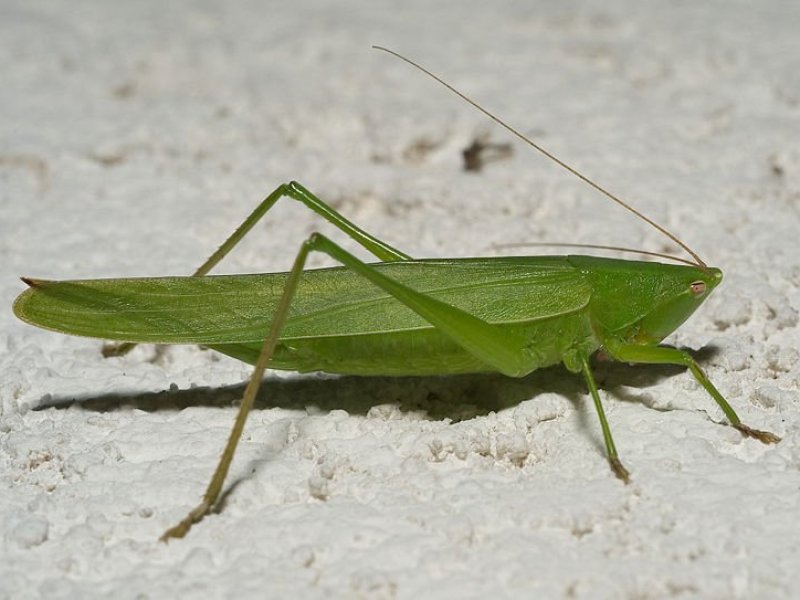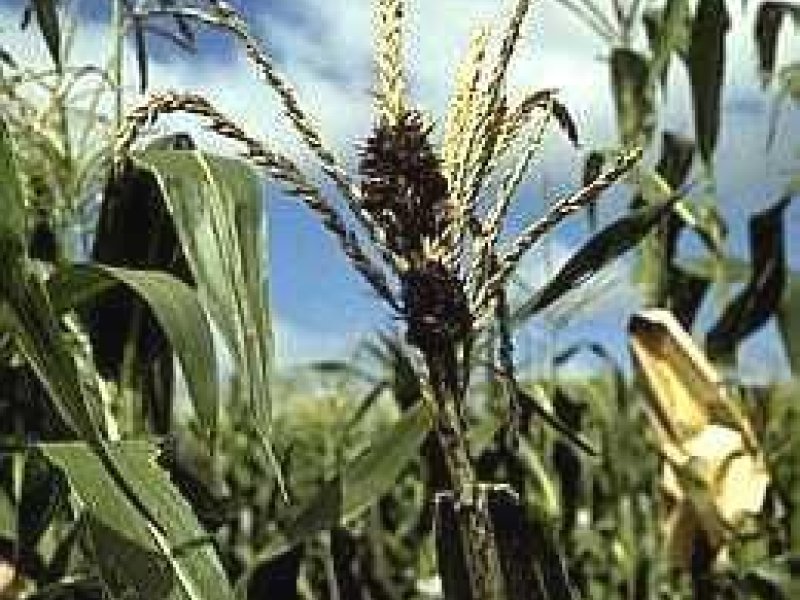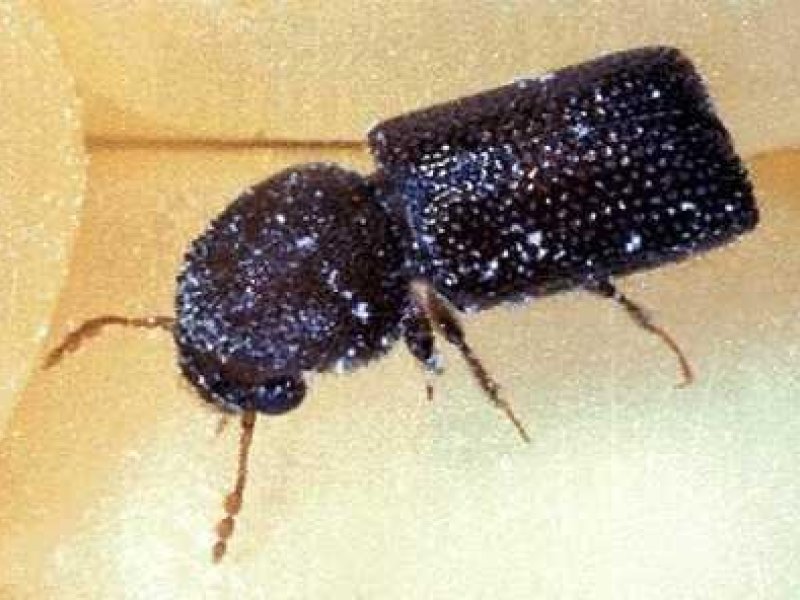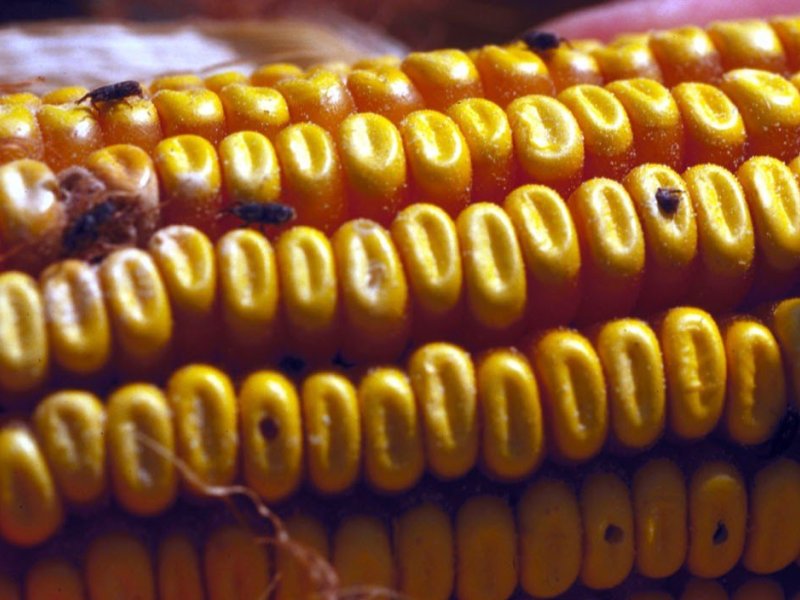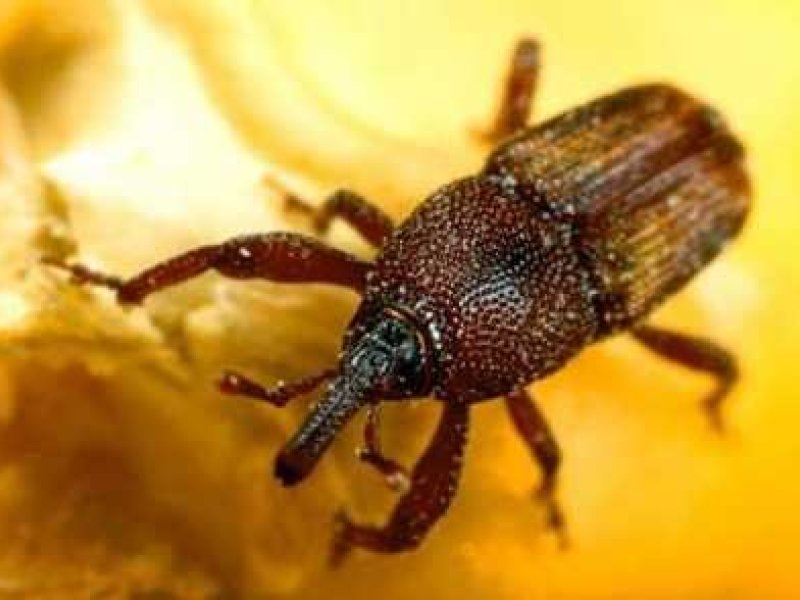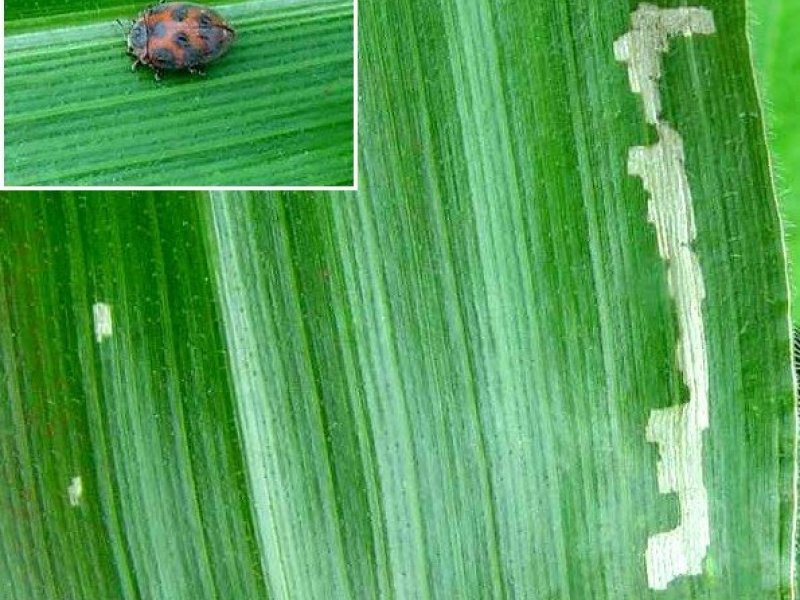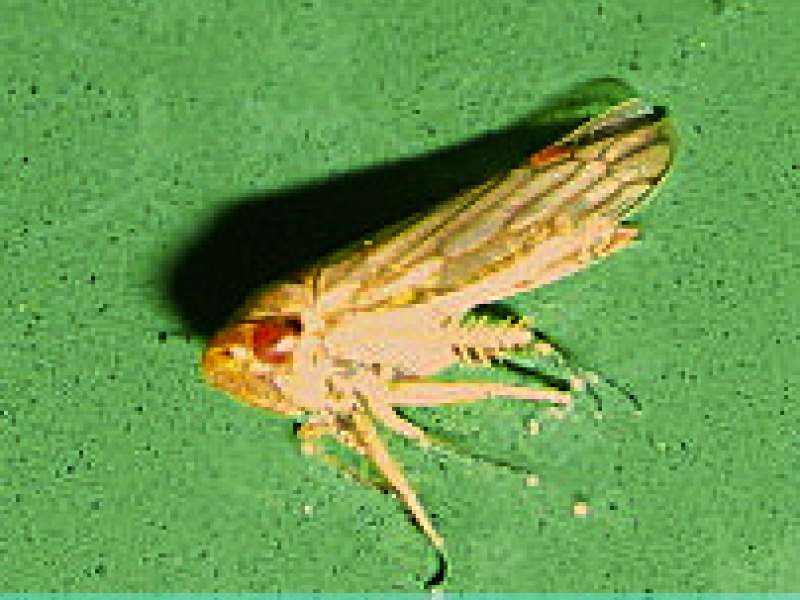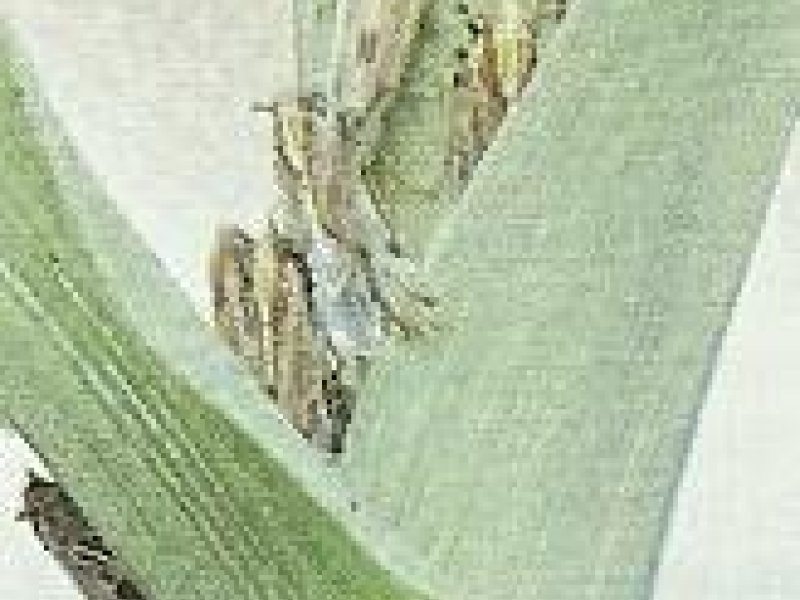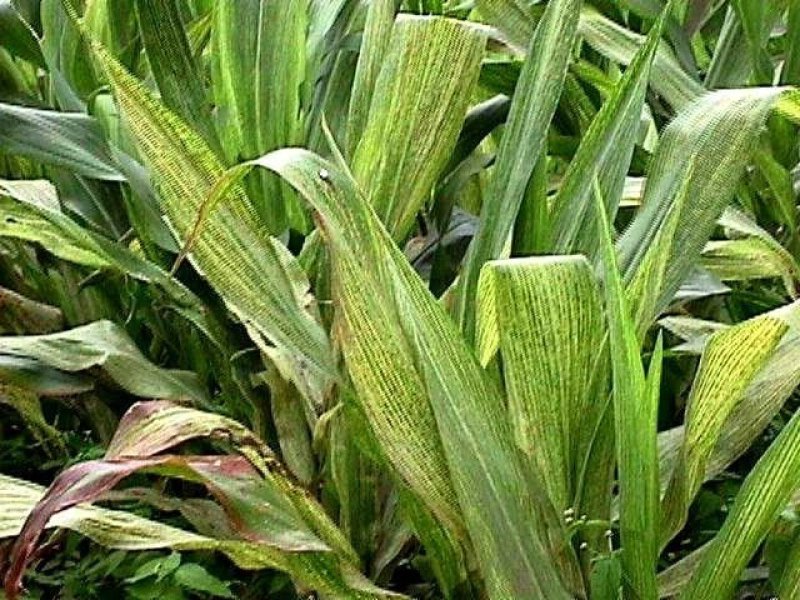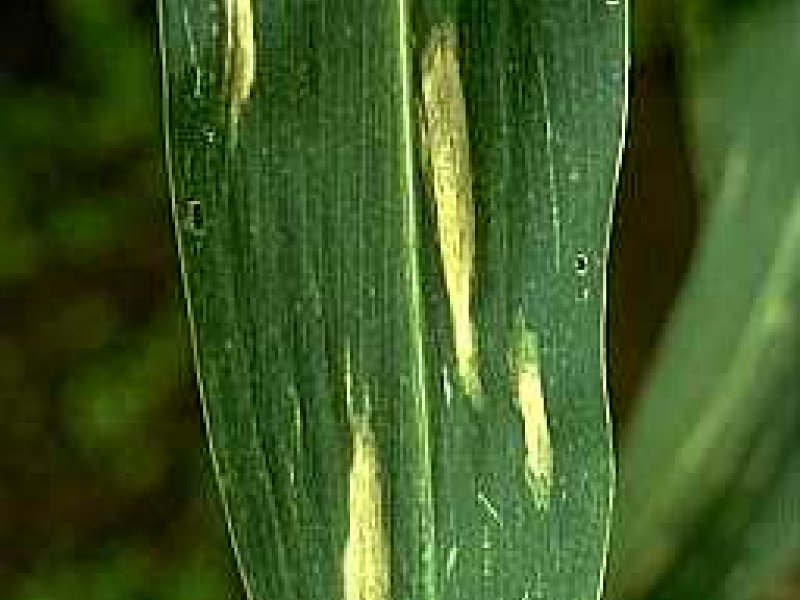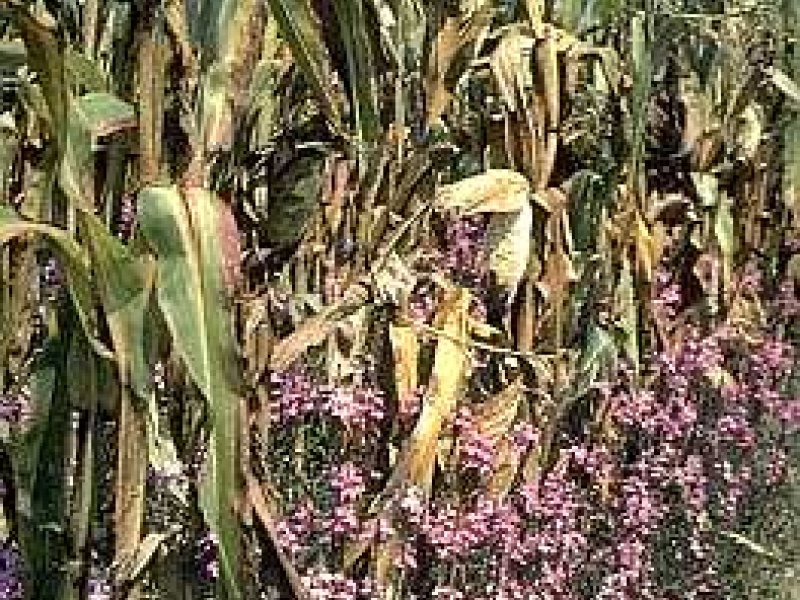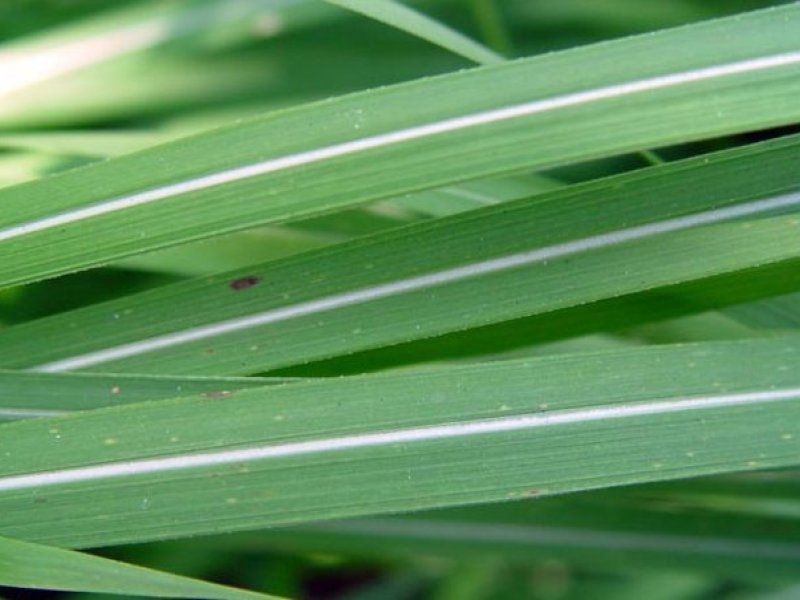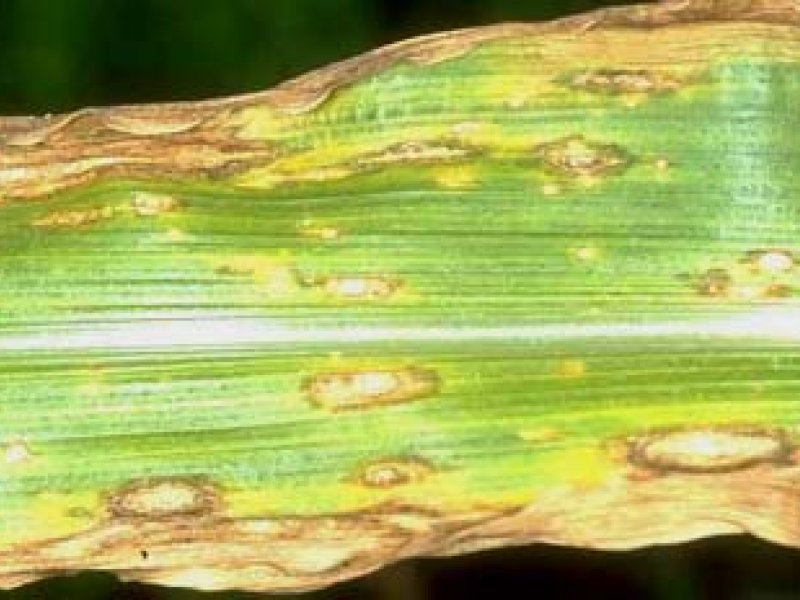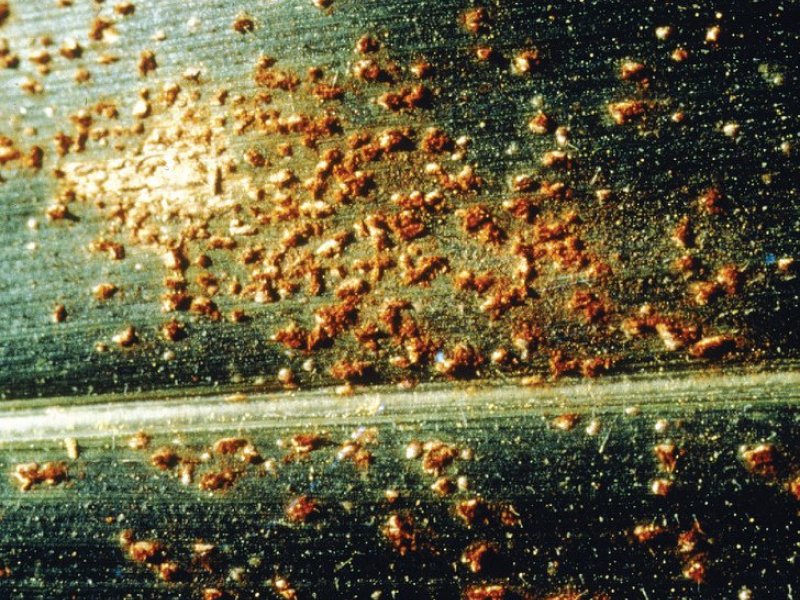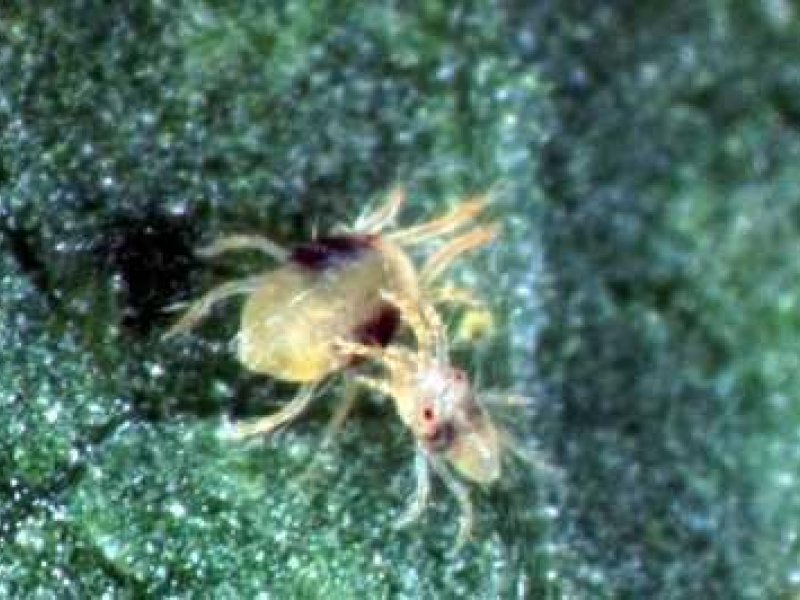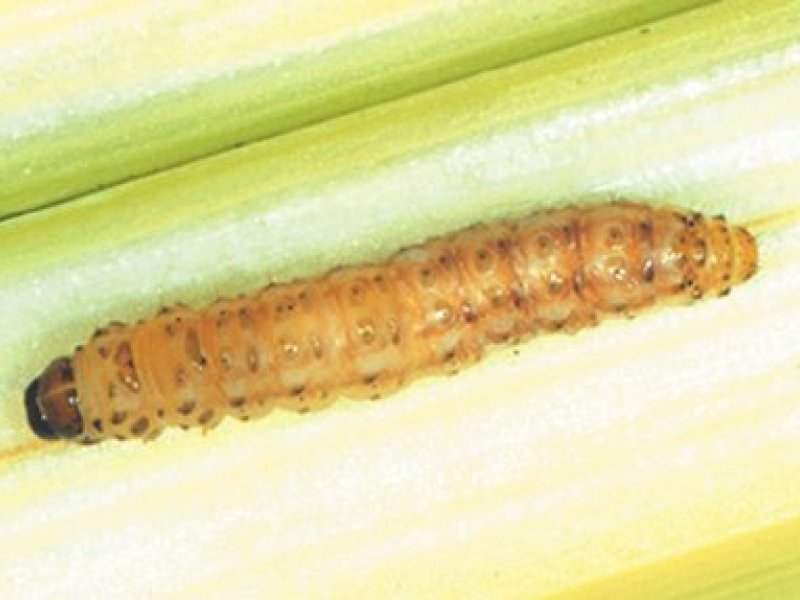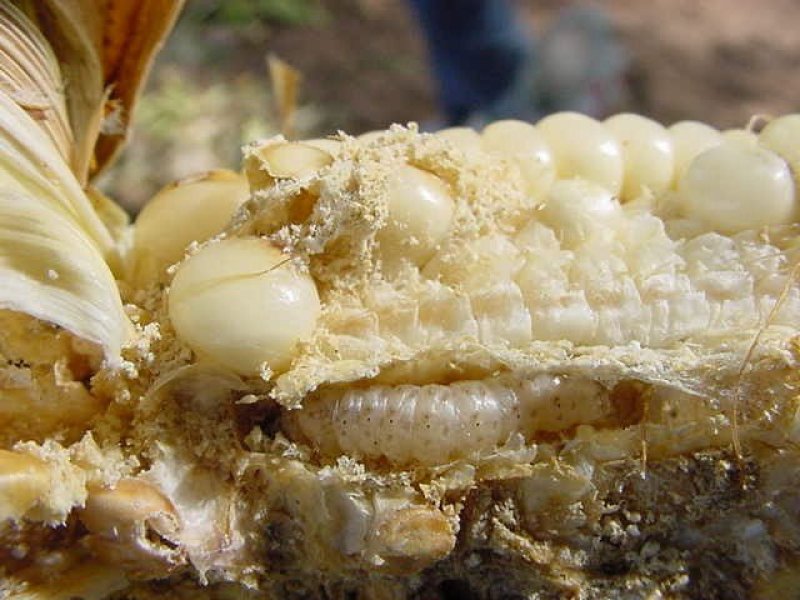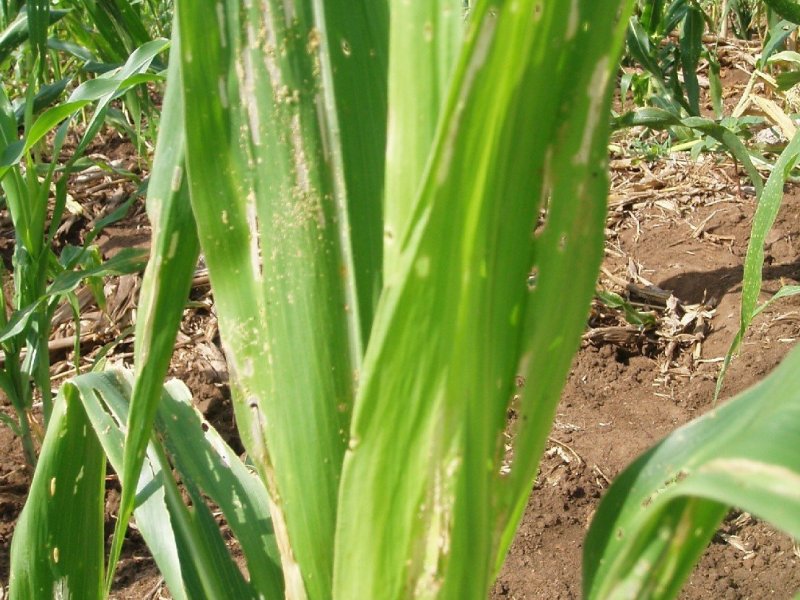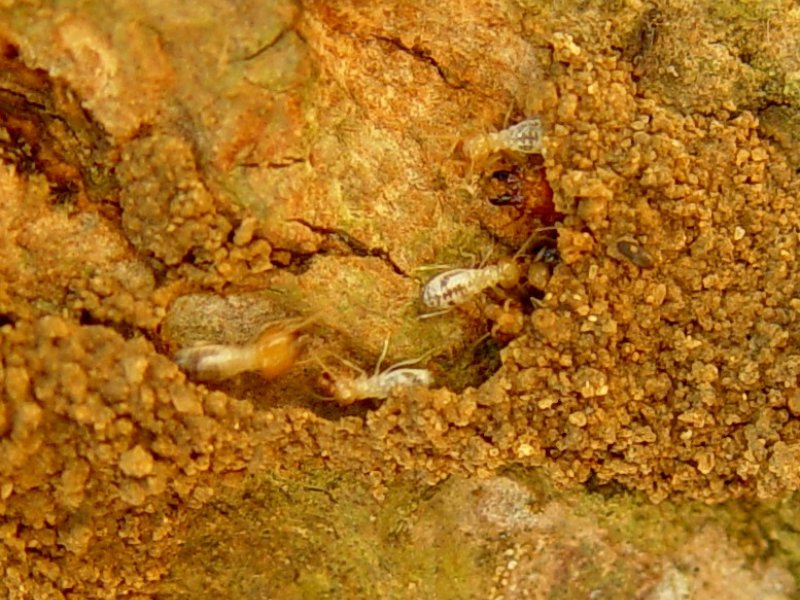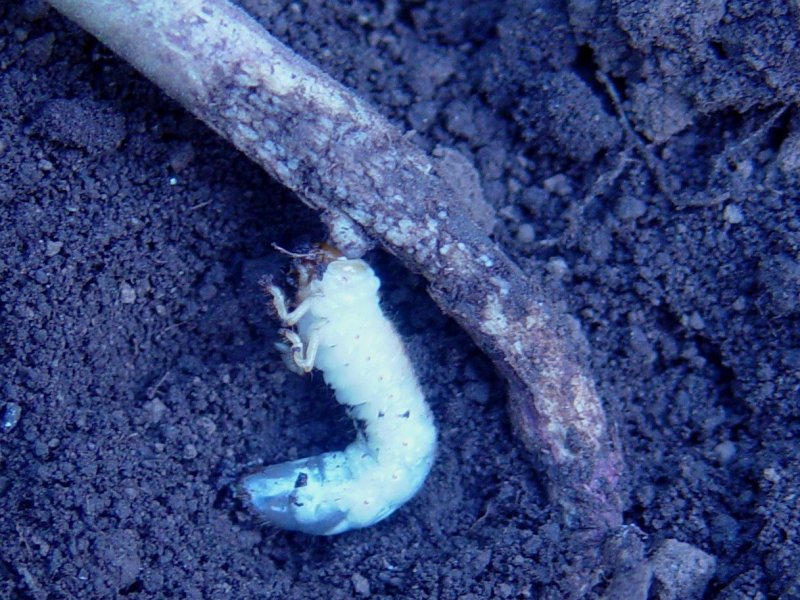|
African armyworm (Spodoptera exempta) The African armyworm is a very damaging pest, capable of destroying entire crops in a matter of weeks. Although they are regarded as occasional pests, in an outbreak large number of caterpillars will appear destroying the whole plant to ground level.
|
|
|
What to do:
|
|
African bollworm (Helicoverpa armigera) Caterpillars of the African bollworm also known as the corn worm or earworm attack mainly the developing cobs, although they may occasionally feed in the leaf whorl or on tender tassels. Eggs are laid on the silks. Caterpillars invade the cobs and feed on developing grain. Development of secondary infections is common. Local outbreaks of this pest are sometimes severe.
|
|
|
What to do:
|
|
Stemborers: African maize stalkborer (Busseola fusca) Stemborers are the most important insect pests of maize in sub-Saharan Africa. Yield losses vary between 10-70%. Several species have been reported. The importance of a species varies between regions, within a country or even the same eco-region of neighbouring countries. At least four species attack maize in eastern and southern Africa, with yield losses reported to vary from 20 to 40%, depending on agroecological conditions, crop cultivars, agronomic practices and intensity of infestation.
The most important are the African maize stalkborer (Busseola fusca) and the spotted stemborer (Chilo partellus) (see also below).
The pink stalkborer (Sesamia calamistis) and the sugarcane stalkborer (Eldana saccharina) are of minor importance in maize.
Early warning signs: Young plants have pinholes in straight lines across the newest leaves. This is the time to treat - before the caterpillars move into the stem. |
|
|
What to do:
|
|
Angoumois grain moth (Sitotroga cerealella) The larvae of the Angoumois grain moth penetrate and feed inside maize grain. This insect may also infest the crop in the field prior to harvest. The moths are small (nearly 1 cm long) yellowish or straw-coloured, a have a fringe along the posterior margins of the wings. They can be observed flying around infested stores. Female moths lay eggs at night. Eggs are laid singly or in clumps on the outside of cereal grains, in cracks, grooves or holes made by other insects. Eggs are initially white turning red near hatching. The larvae are whitish. The larvae prepare a round exit hole for the moth, leaving the outer seed wall only partially cut as a flap over the hole, resembling a trap door. The adult pushes its way out through this "window" leaving the trap door hinged to the grain. Infested grains can be recognised by the presence of these small windows. The adult lifespan may be up to 15 days, and 1 female can lay over 100 eggs.
|
|
|
What to do:
|
|
Maize aphid or corn leaf aphid (Rhopalosiphum maidis) It is dark green to bluish-green in colour with black cornicles. Particularly during dry/periods the colonies appear on the inflorescences and young leaves. Feeding by this aphid causes yellow mottling, but this damage is seldom of economic importance. Their role as vector of the sugarcane virus, maize dwarf mosaic virus and maize leaf-fleck virus makes them a pest of considerable importance. This aphid usually attacks maize plants at the end of the mid-whorl stage. Aphid colonies may completely cover emerging tassels, and the surrounding leaves, preventing pollen release. In severe outbreaks the ear shoot is also infested, and seed set may be affected. |
|
|
What to do:
|
|
Common rust (Puccinia sorghi) It is recognised by the appearance of circular to elongate pustules scattered over both surfaces of the leaf. Pustules are powdery and cinnamon-brown in colour. They contain masses of spores (uredospores). Pustules can appear on any above-ground part of the plant, but they are most abundant on the leaves. With time the pustules split exposing the spores, which are spread by wind and initiate new infection. As maize matures, colour of spores in pustules change from reddish to black due to formation of teliospores (resting spores). The disease is spread by air transport.
|
|
|
What to do:
|
|
Common maize smut (Ustilago maydis) Characteristic symptom of common smut is formation of galls or tumuors on above-ground parts of maize plant. Galls frequently are from one to several centimetres in diameter. The galls are at first covered by a shining, whitish-green membrane. As the gall enlarges, the membrane ruptures, exposing a powdery black mass of spores.
|
|
|
What to do:
|
|
Couch grass or Bermuda grass (Cynodon dactylon) It is a spreading perennial grass with vigorous mat-forming stolons. It reproduces and spreads mostly by means of rhizomes but also propagates by seed. This grass is considered as one of the most important weeds in the world. It is present in virtually every tropical and subtropical country and in virtually every crop in those countries. Couch grass and other species of Cynodon are common in East Africa, and some species are occasionally troublesome as a weed of arable land and perennial crops. Couch grass is reported in Ghana as a problem in crops such as eggplant, okra, onion, peppers and tomato.
|
|
|
What to do:
|
|
Cutworms (Agrotis spp. and other species) Cutworms cut maize seedlings at or a little below ground level, make small holes along the initial leaves, or remove sections from the leaf margins.
|
|
|
What to do:
|
|
Ear rots (Gibberella zeae / G. fujikuroi) Characteristic symptoms include pink to brick-red colour on ears, husks and kernels. The fungi often gain entrance to the ears through channels made by earworms and borers. Bird damage to the ears also facilitates disease infection.
Symptoms Roots: dry rot. Seedlings: blight and subsequent death of the seedling. Leaves: leaves become a dull green colour when rots and stalks are infected early. Stalks: lesions are a dark brown to black colour in which black perithecia may be produced near the lower nodes. The pith is shredded and is pink to red in colouration. Ears: the fungus infects the ear via the silk channel and causes a red rot of the kernels from the tip of the ear. This may spread over the whole ear. |
|
|
What to do:
|
|
Fall armyworm (Spodoptera frugiperda) The fall army worm is larvae stage of fall army worm moth. It is a migratory pest native to America and was first reported in Africa in 2016. The army worm causes damage by feeding on leaves and stems of maize, rice, sorghum, sugarcane, vegetable and cotton. Fall army worm damages maize in all stages. In maize seedlings, it causes damage by feeding within the whorl. Larger larvae can cut the base of the plant. Mature plants suffer attack on reproductive structures. Symptoms of army worm damage in maize are a mass of holes on leaves and the whorl (funnel), ragged edges and larval frass. Young larvae skeletonize the leaf lamina. Severe feeding damage to young plants can kill the growing point; causing 'dead heart' in maize. Maize cobs are attacked by larvae boring through the kernels. At high densities, large larvae may act as armyworms and disperse in swarms, but they often remain in the locality on wild grasses, if available. |
|
|
What to do:
|
|
Grasshoppers and locusts Several species of grasshoppers and locust feed on maize. The edible, a long horned grasshopper Homorocoryphus nitidulus vicinus (Ruspolia differens) has been reported to occasionally attack maize in Tanzania (Bohlen, 1973). This grasshopper attacks maize in the silking stage, arresting pollination. Other grasshoppers and locust attack maize from the mid-whorl stage to maturity, and may consume every part of the plants. Attacks vary in severity from location to location.
|
|
|
What to do:
|
|
Grey leaf spot (Cercospora zeae-maydis Symptoms are similar to Southern leaf blight but the spots are much narrower. They are initially light brownish in colour, and with age they bleach to ashen grey surrounded by narrow light-brownish border. When wet, spore mass is formed on the spots with a light shade. This disease is favoured by prolonged periods of high relative humidity. It can cause yield losses of 30 to over 50%. |
|
|
What to do:
|
|
Head smut (Sphacelotheca reiliana) The first symptoms become evident when tassels and cobs (ears) appear. These parts may be completely or partly converted into smut galls. Smut galls are initially covered by a delicate membrane that breaks open and exposes a mass of reddish-brown to black spores and strands of vascular tissue. The strands or fibres in the galls distinguish this disease from common smut. Head smut is seed-borne.
|
|
|
What to do:
|
|
Larger grain borer (Prostephanus truncatus) and the grain weevils (Sitophylus spp.) They attack stored maize grains. Both the adults and the larvae (grubs) of these beetles feed in the grains. Adults come from infested cobs in the field or from an infested maize store and lay eggs in the grains. They attack maize both in the field and after harvest. Attacked maize grains lose all their contents and are not fit to eat. These pests become a serious problem in short time if no control measures are applied. The larger grain borer also attacks dried cassava roots and even the wooden structures of the stores.
|
|
|
What to do:
|
|
Maize ladybird beetle (Epilachna similes) The adult is oval in shape, about 6 mm in length and reddish brown in colour with black spots on the wing covers. The body is covered with short, light coloured hairs. The larvae are 7-9 mm in length, soft and covered with dark coloured spines. They pupate on leaves. Both larvae and adults of the maize ladybird beetle feed on leaves, scrapping them, usually on the underside, leaving the upper epidermis intact. This beetle will cause much damage only when present in large numbers. It also attacks cereals such as wheat and sorghum. The maize ladybird beetle rarely causes serious defoliation and therefore control is usually not necessary. |
|
|
What to do:
|
|
Maize leafhoppers (Cicadulina spp.) The adults are about 3 mm long, slender and cream to pale yellow green in colour. These leafhoppers have two small black spots between the eyes and brown marks behind the eyes extending along the body. They have brown lines along the wings. They usually hop away when disturbed. The direct damage cause by maize leafhoppers by sucking plants is insignificant, but the indirect damage is high because they transmit the maize streak virus, a major disease of maize. Cicadulina mbila is the most important vector.
Control of the maize leafhoppers is difficult since they are very active, remain infectious for a long time and are very quick in transmitting the virus. |
|
|
What to do:
|
|
Maize lethal necrosis (MLN) A serious new disease of maize appeared in the farmers' fields in eastern Africa in 2011. Called maize lethal necrosis (MLN; or corn lethal necrosis, CLN), it can devastate maize crops. Infection rates and damage can be very high, seriously affecting yields and sometimes causing complete loss of the crop. The disease is difficult to control for two reasons: 1.It is caused by a combination of two viruses that are difficult to differentiate individually based on visual symptoms. 2.The insects that transmit the disease-causing viruses may be carried by wind over long distances. MLND is mainly spread by a vector, transmitting the disease from plant to plant and field to field. The most common vectors are maize thrips, rootworms, leaf beetles and aphids. Hot spots appear to be places where maize is being grown continuously. In Africa, the disease was first reported in Kenya, (South Rift Valley - Bomet and Naivasha districts) in September 2011 although its extent at that point suggested that the disease has been present for some time. According to the Kenyan Ministry of Agriculture, two percent of the maize harvest was affected in 2012. MLND has also spread rapidly into Tanzania, Uganda and South Sudan in the meantime. National and global research and extension organizations, laboratories, and seed companies are working together to control the spread of the disease and to develop and deploy disease-resistant maize varieties for the farmers as soon as possible.
For more information click here Cimmyt website
|
|
|
What to do:
Prevention:
Control:
|
|
Maize plant hopper (corn lantern fly) (Peregrinus maidis) It is 4-5 m long and greyish in colour. The transparent wings are about twice as long as the body and show marked dark-brown veins. It is commonly found in groups in the funnel of the plants, the whorl, leaf sheath or underside of leaves. This insect produces large quantities of honeydew. As a result, sooty mould is often evident near the sites of aggregation. Nymphs and adults are in close association with ants, which feed on the honeydew produced by this plant hopper. This plant hopper transmits the maize mosaic nucleorhabdovirus (MMV), maize stripe tenuivirus (MSpV), and maize line virus that can become a limiting factor in maize production.
|
|
|
What to do:
|
|
Maize streak virus The virus causes a white to yellowish streaking on the leaves. The streaks are very narrow, more or less broken and run parallel along the leaves. The virus is transmitted by leafhoppers (Cicadulina mbila and C. bipunctella zeae). Maize streak virus is a serious constraint to maize production in sub-Saharan Africa. The reduction in yields depends on the time of infection. Plants infected at early stage usually do not produce any cobs. Yield losses in East Africa vary between 33 and 55% under natural infection conditions. In Nigeria, 75-100% of maize plants can be infected at the end of the growing season. However, resistant varieties in these areas appear to withstand these epidemics (Anon., 1983). Sugarcane, sorghum, millet, wheat, barley, oats, rye and wild grasses can also be severely affected.
|
|
|
What to do:
|
|
Northern leaf blight Exserohilum turcicum (Helminthosporium turcicum / Dreschslera turcica / Trichometasphaeria turcica / Setosphaeria turcica) Small oval (egg-shaped) spots first appear as water-soaked areas. They are dark and greyish-green in colour, turning greenish tan. With age they get bigger and become cigar-shaped. After rains or heavy dews, spores develop abundantly on both surfaces of the spots, particularly at the centres, giving a dark-green, velvety look to the spots. The spots may join and form large areas, which may kill entire leaves. Heavily infected leaves appear dry as if affected by drought. The disease is favoured by heavy and frequent rains, high relative humidity (above 90%) and relatively low temperatures (20-25°C). Warm dry conditions check disease development.
|
|
|
What to do:
|
|
Purple witchweed (Striga spp.) The parasitic weeds Striga spp. known as witchweeds, are important pests of maize, particularly in drier areas. The weeds grow on the roots of maize affecting development of maize plants. The young weeds tap the roots of maize plant and draw water and nutrients. A single weed plant produces many thousands of tiny seeds that survive in the soil for long periods. A heavy infestation can cause complete yield loss.
Striga weeds infest 40% of the arable land in the savannah region, causing annual crop losses of 7 to 13 billion dollars. Around the Lake Victoria basin infestation by Striga hermonthica causes 30 to 100% loss in maize yield. Striga infestation is associated with increased cropping intensity and declining soil fertility. Witchweed infestation has resulted in the abandonment of much arable land by farmers in Africa. The problem is more serious in areas with low soil fertility and rainfall. None of these methods described will, alone, provide complete control and without complete control there is the certainty that surviving plants will mature and replenish the soil seed bank. Therefore, integration of one or more methods is essential for any substantial reduction of the problem. Furthermore, such integrated treatments will almost certainly need to be repeated over a number of years for long-term control.
|
|
|
What to do:
|
|
Satintail (Imperata cylindrica) In south-western Nigeria, satintail is a major weed reducing maize yields. The rhizomes of this weed often reduce the efficacy of farmers' weed control practice (slashing followed by 2-4 times of additional weeding) and contribute to high yield losses.
|
|
|
What to do:
|
|
Southern leaf blight Bipolaris maydis (Helminthosporium maydis / Cochliobolus heterostrophus) Symptoms first appear as small yellow dots that become elongated between veins. They later become brownish to creamy white in colour with reddish to purplish brown borders. Light brown leaf spots with a brown margin, at first elliptical, becoming rectangular, up to 25 mm long and 2 - 6 mm wide. The spots are at first restricted by the leaf veins, but later they may merge. Leaves dry out and die prematurely. Silks, portions of the husks and cobs may turn black. A black mould may develop on cobs. Disease development is promoted by prolonged wetness on foliage, extended dew, RH (97-100%) and relatively warm temperatures (24-35°C). Spread is by airborne spores; and the fungus is also seed-borne. Survival in soil occurs for up to 12 months. |
|
|
What to do:
|
|
Southern rust (Puccinia polysora) Symptoms resemble those of common rust, particularly in the uredial stage (urediospores). The cinnamon-brown pustules tend to be smaller and more circular in outline than those of common rust. Pustules of telial stage (teliospores) are chocolate brown to black and circular to elongate. They are distinguished from common rust by retention of the epidermis of the leaf over the pustule for a long time. No alternate host has been reported for Southern rust.
|
|
|
What to do:
|
|
Spider mites They can damage maize from the seedling stage to maturity. The presence of small, faint yellow blotches on the lower leaves is an indication of spider mite injury. As the colonies of mites increase in size they cause the lower leaves to become dry. The mites then migrate to the upper leaves. In Africa several species of spider mites have been reported on maize (mainly Tetranychus spp. and Olygonichus spp.). In Kenya, they are occasionally found on maize, but usually they are not of economic importance.
|
|
|
What to do:
|
|
Stemborers: Spotted stemborer (Chilo partellus) Stemborers are the most important insect pests of maize in sub-Saharan Africa. Yield losses vary between 10-70%. Several species have been reported. The importance of a species varies between regions, within a country or even the same eco-region of neighbouring countries. At least four species attack maize in eastern and southern Africa, with yield losses reported to vary from 20 to 40%, depending on agro-ecological conditions, crop cultivars, agronomic practices and intensity of infestation.
The most important are the African maize stalkborer (Busseola fusca) (see above) and the spotted stemborer (Chilo partellus). The pink stalkborer (Sesamia calamistis) and the sugarcane stalkborer (Eldana saccharina) are of minor importance in maize.
Early warning signs: Young plants have pinholes in straight lines across the newest leaves. This is the time to treat - before the caterpillars move into the stem. |
|
|
What to do:
|
|
Termites (Microtermes spp., Macrotermes spp., Allodontermes spp., and Odontotermes spp) Often referred to as "white ants", they occasionally cause partial or total defoliation of maize seedlings, but are mainly damaging to older maize plants. Severely damaged plants may lodge and be completely destroyed by termites. The longer a field has been cultivated, the greater will be the yield losses caused by termites. Their feeding inside the stems causes the plant to wither and sometimes die. Termites begin to attack the roots and stems about 3 months after planting, and eventually cover them with tunnels built of soil. As plants mature the amount of damage increases rapidly. Infestation is particularly serious in dry season. It has been established that termites can damage up to 25% of maize crops in Malawi (WISARD Project Information, 2001).
|
|
|
What to do:
|
|
White grubs White grubs are the larvae of scarab "chafer" beetles. They are white, C-shaped with a brown head and 3 pair of legs. Some species of whitegrubs (e.g. Phyllophaga spp, Heteronychus spp.) feed on roots of maize plants. Root damage is manifested by wilting seedlings, poor stands, and patches of tilted or lodged plants showing uneven growth. Injured plants can easily be pulled out of the ground.
Feeding of adults on maize leaves is usually not of economic importance. However, adults of the black maize beetles (Heteronychus spp.) are reported as major pests of cereals in many parts of Africa. They eat the stems of young shoots just below the ground. One adult beetle may destroy several seedlings in a row.
|
|
|
What to do:
|
Geographical Distribution in Africa
Geographical Distribution of Maize in Africa. Updated on 1st April 2019. Source FAOSTAT
General Information and Agronomic Aspects
Maize is the most important cereal crop in sub-Saharan Africa. It is a staple food for an estimated 50% of the population. It is an important source of carbohydrate, protein, iron, vitamin B, and minerals. Africans consume maize in a wide variety of ways (maize meal, porridges, pastes and beer). Green maize, fresh on the cob, is eaten baked, roasted or boiled. Every part of the maize plant has economic value: the grain, leaves, stalk, tassel, and cob can all be used to produce a large variety of food and non-food products. In sub-Saharan Africa maize is mostly grown by small-scale farmers, generally for subsistence as part of mixed agricultural systems. The systems often lack inputs such as fertiliser, improved seed, irrigation, and labour. According to FAO data, Africa produced 7.4% of the 1, 135 million tonnes produced worldwide in 40 million hectares in 2017 (FAOSTAT, 2017).
Maize is also a very important feed for livestock. It is processed in industries to produce oil and starch. In Kenya, maize is produced in both small and large farms. Most of the maize crop is however produced on small scale farms. Large scale maize production goes on in Trans Nzoia, Nakuru and Uasin Gishu counties.
Table 1: Nutritive Value Per 100g of Edible Portion
| Raw or Cooked Maize | Maize Flour | Yellow Maize Cooked | Maize Vegetable Oil |
| Food Energy (Calories/%daily value) | 364/18% | 108/5% | 884/44% |
| Carbohydrates (g/%DV) | 76.4/25% | 25.1/8% | 0.0/0% |
| Fat (g/%DV) | 5.1/8% | 1.3/2% | 100/154% |
| Protein (g/%DV) | 8.7/17% | 3.3/7% | 0.0/0% |
| Calcium (g/%DV) | 5.0/1% | 2.0/0% | 0.0/0% |
| Phosphorus (mg/%DV) | 263/26% | 103/10% | 0.0/0% |
| Iron (mg/%DV) | 1.7/10% | 0.6/3% | 0.0/0% |
| Potassium (mg/%DV) | 381/11% | 249/7% | 0.0/0% |
| Vitamin A (I.U) | - | 2.0 IU/0% | 0.0 IU/0% |
| Vitamin C (I.U) | - | 6.2/10% | 0.0/0% |
| Vitamin B6 (I.U) | 0.5/23% | 0.1/3% | 0.0/0% |
| Vitamin B12 (I.U) | - | 0.0/0% | 0.0/0% |
| Thiamine (mg/%DV) | 0.2/11% | 0.2/14% | 0.0/0% |
| Riboflavin (mg/%DV) | 0.2/14% | 0.1/4% | 0.0/0% |
| Ash (g/%DV) | 1.4 | 0.7 | 0.0 |
*Percent Daily Values (DV) are based on a 2000 calorie diet. Your daily values may be higher or lower, depending on your calorie needs.
Climate Conditions, Soil and Water Management
Maize is a versatile crop, growing across a range of agro-ecological zones. With its large number of varieties differing in period to maturity, maize has a wide range of tolerance to temperature conditions. It is essentially a crop of warm regions where moisture is adequate. The crop requires an average daily temperature of at least 20℃ for adequate growth and development. Optimum temperature for good yields is around 30℃. The time of flowering is influenced by photoperiod and temperature. Maize is considered to be a quantitative short-day plant (short days can induce premature flowering). It is grown mainly from 50°N to 40°S and from sea level up to about 3000m altitude at the equator. At higher latitudes, up to 58°N, it can be grown for silage.
Maize is especially sensitive to moisture stress around the time of tasselling and cob formation. It also needs optimum moisture conditions at the time of planting. In the tropics it does best with 600 - 900mm of rain during the growing season. Maize can be grown on many soil types, but performs best on well-drained, well-aerated, deep soils containing adequate organic matter and well supplied with available nutrients. The high yield of maize is a heavy drain on soil nutrients. Maize is often used as a pioneer crop, because of the high physical and chemical demands it makes to the soil. Maize can be grown on soils with a pH from 5 - 8, but 5.5 - 7 is optimal. It belongs to the group of crops that is considered to be sensitive to salinity. Since a young crop leaves much of the ground uncovered, soil erosion and water losses can be severe and attention should be paid to adequate soil and water conservation measures.
Maize Varieties
There are few pure varieties of maize at present because farmers tend to grow the more productive hybrids and composites. The Kenya Flat Complex is one of the low yielding varieties but has good sheathing which prevents damage by weevil when stored with husks on.
Several hybrids and composites are produces in various research stations like the National research Staation – Kitale, Embu Research Station, Katumani Research Station Machakos and Coast Agricultural Research Station – Mtwapa.
Hybrids are bred by crossing inbreed lines or varieties under conditions of controlled pollution. Composites on the other hand are bred growing a number of varieties together under uncontrolled pollination, there is free inter pollination.
These hybrids and composites are produced for specific altitudes in the country. Some of these are Kitale hybrids for example 614, 622, 625, 626. 627, and 632. They are generally grown in medium to high altitude zones. Embu hybrids include 511 and 513, they grow best in medium altitude zones. Katumani composites have been developed for lower altitude zones. Coast composites, Pwani hybrid 1 and pwani hybrid 4 have been developed at the Coast Agricultural Research Station – Mtwapa for cost province. Others include double cob varieties for example DH01 and DH02.
The choice of appropriate maize varieties for a given location is very important because every variety has extensively been tested and recommended based on climatic conditions, soil type, yield potential, tolerance/resistance to pest and diseases or maturity period among others.
Types of Varieties
Local Seeds: Low to medium yields, usually well sheathed and so more resistant to weevil attack in storage, possibly more palatable to local tastes. Example: Kikuyu maize. Exotic varieties of maize can be collected to add genetic diversity when selectively breeding new domestic strains
Seed Selection and Treatment
Maize variety selection depends on:
i) End-use
Maize is primarily grown for grains, silage and stock feed. Ensure the variety you grow is suited to the end use market you are aiming for.
ii) Maturity
Plan to sow seeds of chosen variety in the recommended planting windows outlined in Table 2, ensuring maturity, expected rainfall and expected harvest time (days to harvest) . It is also important to ensure harvest will not be far into the dry season as prolonged drought will encourage the onset of aflatoxin in maize.
iii) Stability
Select varieties that have well developed roots, strong stalks, and are resistant to root and stalk rot. These features help prevent the plant from falling over/logging, which can lower the yield and quality of the grain.
iv) Insect and disease tolerance/resistance
Always select a maize variety that is known to have tolerance/resistance to a disease or insect pest common in your area where is to be grown so as to attain maximise yield potential.
Note: If you receive or acquire a new maize variety, then test it on small plots before scaling up the production to big plots. Observe and compare the performance of the new variety with the other varieties at every stage of growth under similar management conditions of planting time, weeding and soil fertility management. This will help you to choose the best performing variety under local prevailing conditions.
Table 2: Maize Growing Zones in Kenya and Recommended Varieties
| Variety | KALRO Maize variety | Year Released/Center/Scientist | Attributes | Uses | Where Grown | Commercialization By Who |
| H511 | 1967 Kenya Seed Co/KARI | Optimal production altitude range (Masl) 1000-1500 m Maturity: 4-5 months Grain yield (t ha-1 ) 4-7 Novelty: Medium maturity | Used to make maize flour, mixed with beans to make githeri or with cow peas for muthokoi, can be eaten as roasted or boiled maize whole on cob, livestock feed, corn oil | Western Kenya, Lake region, South Rift, Meru and Central | Kenya Seed Co/KARI | |
| H622 | 1967 Kenya Seed Co/KARI | Optimal production altitude range (Masl) 1200-1700 m Maturity: 5-7 months Grain yield (t ha-1 ) 6-8 Novelty: Large kernels Dent | Used to make maize flour, mixed with beans to make githeri or with cow peas for muthokoi, can be eaten as roasted or boiled maize whole on cob, livestock feed, corn oil | Western Kenya, Lake region, South Rift, Meru and Central | Kenya Seed Co/KARI | |
| H632 | 1967 Kenya Seed Co/KARI | Optimal production altitude range (Masl) 1200-1700 m Maturity: 5-7 months Grain yield (t ha-1 ) 6-8 Novelty: Large kernels Dent | Used to make maize flour, mixed with beans to make githeri or with cow peas for muthokoi, can be eaten as roasted or boiled maize whole on cob, livestock feed, corn oil | Western Kenya, Lake region, South Rift, Meru and Central | Kenya Seed Co/KARI |
Source: KALRO-KCEP Technology Validation Report, 2016
Table 3: Maize Varieties in Kenya, their Ezo-Zones, Time it Takes to Mature and Their Yield Potential
| Eco-zone and main areas where found. | Recommended varieties | Maturity (months) | Yield potential (bags/ acre) |
|
Highland zones with high rainfall; Altitude:15002100m above sea level; Areas: Trans Nzoia, Uasin Gishu, Nakuru, Kericho, Nandi, Bungoma, Laikipia, Kisii, Narok and Tea zones of Central and Eastern provinces. |
H 627 H 626 H 625 H614D |
6-8 6-8 6-8 6-9 |
42 38 34 32 |
|
Highland zones, high rainfall; Altitudes: 1000-1700m above sea level; Areas: Baringo, Siaya, Kisumu, Busia, Bungoma, Kakamega, Nakuru, South, Nyanza, Taita Taveta |
H632, WE1101 H622 |
6-8 6-8 |
24 22 |
|
Coffee zone medium long growing season; Altitude: 1000-1800m above sea leave; Areas: Coffee zones of Central and Eastern provinces, Kisii, Narok, Nakuru, Siaya, Kisumu, Busia, Kakamega,Bungoma, West Pokot, Keiyo, Marakwet |
H513 PHB3253 H511 Duma 43 |
4-5 4-5 4-5 4-5 |
20 20 16 18 |
|
Dryland areas. Marginal areas with low rainfall.(400mm-800mm); Altitude: 1000-1800 above sea level; Areas: Kitui, Machakos, West Pokot, Makueni, Kajiado, Isiolo, Lower Meru and Embu, Siaya, Kisumu |
KCB, KDV 1, KDV 4 and KDV 6, Sungura, Sawa DH01 DH02 |
3-4 3-4 3-4 |
12 14 14 |
| AItitude: 800 - 1200 m above sea level, Drier areas same as for Kitui, Machakos, Makueni drier areas. | DLC | 3-4 | 11 |
| Lowland zones - Hot humid; Altitude: 0-1200m above sea level |
PH4 PH1 |
3-4 3-4 |
18 14 |
Source: KALRO-KCEP Technology Validation Report, 2016
Table 4: Recommended Maize Varieties in the Western Kenya and Rift Valley Regions
| Variety | Source | Agro - Ecological Zone where grown | Yield potential (90 kg bag/acre) |
| H 6218 | Kenya Seed Company | Highlands | 56 |
| H 6213 | Kenya Seed Company | Highlands | 52 |
| H 6210 | Kenya Seed Company | Highlands | 50 |
| H614D | Kenya Seed Company | Highlands | 33 |
| H629 | Kenya Seed Company | Highlands | 35 |
| H624 | Kenya Seed Company | Highlands | 35 |
| H 517 | Kenya Seed Company | Highlands | 20 |
| P 30G19 | Pioneer Seed Company | Medium | 30 |
| SIMBA 61 | Seedco Company | Medium | 30 |
| WH505 | Western Seed Company | Medium | 30 |
Source: KALRO-KCEP Technology Validation Report, 2016
Highland Maize Varieties: These varieties are bred and recommended for medium to high altitudes (1500-2400 m) where day temperatures seldom exceed 28°C during growing season and where the night temperatures drop to as low as 80°C. Rainfall requirement ranges from 800-1500 mm. Where similar conditions prevail in the highlands of Tanzania, Uganda and Ethiopia these varieties are recommended. Examples in this group include "H 6210", "H 6212", "H 6213", "H 629" and "KH 600-15A"
Medium Altitude Agro-Ecozone: Altitude range is between 1000 and 1800 m. Some of the varieties in this category include "H513", "H 515" and "H 516". These varieties are commonly grown in coffee growing belts maturing in 4-5 months. The favourable rainfall is between 750-1000 mm
Transitional Zone: The altitude in this zone falls between 1000 and 1500 m where the temperature ranges from 12 to 30°C and has rainfall similar to that of high altitudes. "Hybrid 624" is a typical example in this category.
Lowland Agro-Ecozone: Pwani hybrids ("PH 1" and "PH 4") and "Coast Composite" are fairly short varieties resistant to lodging and more tolerant to moisture stress and recommended for altitude range of 0-1250 m. above sea level with 400 mm of rainfall. They have an added advantage of good husk cover hence reduced crop loss though bird, weevil attack and ear rots. They are also suitable under inter-cropping systems.
Dryland Agro-Ecozone: Examples in this category include "Katumani Composite B" and "DLC 1". Katumani "Composite B" is a fast growing open pollinated variety, which is fairly short and produces short cobs. It is a drought escaping variety flowering within 60-65 days and maturing within 90-120 days. The variety performs well within altitudinal range of 1000-500 m above sea level and is a variety for marginal rainfall areas. The variety requires 250-500 mm of rain, and has performed extremely well in arid marginal areas in many parts of Africa particularly in Somalia, Ethiopia, Sudan, Tanzania and Namibia
Some examples of maize varieties in Tanzania
- "Kilima, "UCA"(OPV): suitable for medium to slightly high altitude (900-1700 m); maturity of 110-130 days; yield potential of 45-65 bags of 90 kg / ha
- "Staha": suitable for low to medium altitude (1-900 m); maturity of 110-130 days; tolerant to drought and also humid conditions
- "TMV-1" (OPV) : suitable for low to medium altitude (1-900 m); maturity of 110-120 days"Katumani,
- "Kito": suitable for low to medium altitude (1-750 m); maturity of 90 days; yield potential of 22-30 bags of 90 kg / ha; drought tolerant
- "Situka"(OPV): suitable for medium altitude (500-1600 m); maturity of 110-120 days; yield potential of 45-65 bags of 90 kg / ha; tolerant to low nitrogen; resistant to cob rots, grey leaf spot and maize streak virus
Some examples of maize varieties in Uganda
- "Longe 4 (OPV)": suitable for low land to mid altitude areas; maturity of 100-115 days; yield potential of 40-55 bags of 90 kg / ha; tolerant to maize streak virus, rust and grey leaf spot.
- "Longe 5 (Nalongo) (QPM Maize)"; suitable for low land to mid altitude areas; maturity of 115 days; potential yield of 40-50 bags of 90 kg / ha; quality protein maize with lysine and tryptophan amino acids; drought tolerant; resistant to maize streak virus, grey leaf spot; moderately resistant to northern leaf blight.
- "Longe 8 H": suitable for mid-altitude; maturity of 120-125 days; potential yield of 88--10 bags of 90 kg / ha; excellent husk cover; tolerant to cob rots, drought and poor soil; resistant to maize streak virus, northern leaf blight and grey leaf spot; a very popular hybrid in Uganda.
Seed Selection, Planting and Field Operations
a). Seed Selection;
Kenya seed company contracts specific farmers to grow maize for seed. The maize is then harvested and treated using Thiram-dindane to prevent pest attack and sold to farmers as seed. Farmers are advised to buy fresh seed for planting every season. This is because of the problem of reduced hybrid vigour in the first generation.
b). Land preparation;
Land on which maize is to be grown should be prepared early to allow stubble enough time to rot. Ploughing is done using disc or mould board ploughs. Harrowing is done where the seedbed is rough, although a fine seedbed is not necessary for maize. Maize does well when grown in rotation with other crops such as beans, tobacco, cotton, groundnuts and Irish potatoes. Maize takes a lot of fertility out of the soil. Continuous cropping of maize should be avoided unless the soil is very fertile or where a lot of fertilizers are applied.
c). Planting Planting Time
Planting should be done quite early in the rains so that the crop can make maximum use of available moisture. Dry planting should be very crucial as delayed planting always reduces yields. Early planting also reduces attack by stalk borers.
Planting should be done within the first two weeks of the onset of rains. It is recommended that there should be at least 30 cm of wet soil throughout the soil profile before sowing. While the hole is still moist, place two to three seeds in an evenly-spaced line in each hole, with one pip at each side and one in the on the other side. Cover the seeds using the soil heaped next to the hole to leave a level surface. Make sure no stones or heavy soil clods cover the seeds. Leave the mulch cover between the holes intact. Try to complete planting in a day to ensure an even germination and later, an even crop canopy, which will shade out any weed growth.
Spacing and plant population per hectare The recommended spacing and planting density of maize for different areas is as shown in table .
|
Region. |
Spacing. |
Density (plants per ha). |
|---|---|---|
|
Highland |
75x25cm 1 plant/hill (pure stand) 75 x 50cm 2 plants/hill (intercrop) |
53,333 53,333 |
|
Medium |
75 x 30cm 1 plant/hill (pure stand) 75 x 60cm 2 plants/hill (intercrop) |
44,444 44,444 |
|
Dry land and coastal |
90 x 30cm 1 plant/hill (pure stand) 90x 60cm 2 plants/hill (intercrop) |
37,850 37,850 |
The appropriate planting depth varies from 2 to 10 cm, depending on the weather conditions and the moisture status of the soil. In the highland and medium areas where the soils are well-drained sandy-loam soils, planting depth of 2 to 3 cm is optimal, as deep seed placement retards germination and emergence of maize seedlings. In dry and coastal low land areas where the soil is dry and/or sandy, maize seed should be planted more deeply (5 to 10 cm). This enables the development of a deep root system to obtain the needed water and nutrients. Deep roots penetrate far into the soil and use moisture and nutrients from the deeper depths of the soil.
d). Weed control
Weeds in maize should be controlled right from the early stages of growth to reduce competition for moisture and nutrients. Two to three weedings should give the crop a chance to grow properly to the point where it can suppress the weeds. Hand weeding is mainly practiced.
Weed control is very important. Maize is very sensitive to weed competition during the first 4-6 weeks after emergence. It should be planted as soon as possible after the preparation of the seedbed. Inter-row cultivation to control weeds and to break up a crusted soil surface may be done until the plants reach a height of about 1 m. In Kenya 2 weedings are necessary for most maize varieties, though a third weeding may be necessary for varieties that need 6 to 8 months. Weeding by hand requires a minimum of 25 man-days/ha.
e). Water management
Irrigation is used in areas of low rainfall and is particularly valuable at the time of tasseling and fertilisation. Irrigation is necessary for production of green maize.
f). Fertilisation
Maize usually responds well to fertilisers, provided other growth factors are adequate. The quantity of manure applied by smallholders is usually very limited. Improved varieties can only reach their high yield potential when supplied with sufficient nutrients. A maize crop of 2 t/ha grains and five t/ha stover removes about 60 kg N, 10 kg P2O5 and 70 kg K2O from the soil. Nitrogen uptake is slow during the first month after planting, but increases to a maximum during ear formation and tasselling. Maize has a high demand for nitrogen, which is often the limiting nutrient. High nitrogen levels should be applied in three doses, the first at planting, the second when the crop is about 50 cm tall, and the third at silking.
Many soils provide substantial amounts of the phosphorus (P2O5) and potassium (K2O) but this is not adequate enough, especially at the seedling stage. Apply P2O5 near the seed for early seedling vigour. K2O is taken up in large quantities but plants' requirement can usually be estimated by soil analysis. K2O deficiency results in leaves with burnt edges and yellow or light green colour and empty cob ends, while P2O5 deficiency results in purple tinged leaves and hollow grains. Nitrogen deficiency shows as yellow or light green stunted plants.Phosphate is not taken up easily by maize and, moreover, some tropical soils are deficient in available phosphate. Zinc deficiency symptoms include shortening of internodes and light streaking of leaves followed by a broad stripe of bleached tissue on each side of the leaf midrib. Occasionally the leaf edges and interior of the stalk at the nodes appear purplish. It is advisable to apply organic manures to improve soil structure and supply nutrients, all before ploughing.
Nitrogen (N) can be applied in organic farming via green manure (legumes fixing N directly from the atmosphere), farmyard manure (FYM) or compost. Phosphorus can be supplied through FYM, compost, and in the form of rock phosphate (available in East Africa as Mijingu rock phosphate). rock phosphate should be applied in the rows or planting holes at planting to promote root formation., Potassium can be supplied through FYM, compost and ashes. However, fertiliser recommendations based on soil analysis provide the very best chance of getting the right amount of fertiliser without over or under fertilising. Ask for assistance from a local agriculturist office.
In rain-fed maize growing areas, plant seeds along with the first rain. This will allow roots to absorb the natural nitrates formed with bacterial action in the soil. Roots are susceptible to poor drainage, which causes stunted and yellowing of leaves. Stagnant water results to loss in N through leaching and denitrification (FADINAP, 2000). For more information on organic plant nutrition click here.
g). Intercropping
In Africa maize does well when intercropped with beans or other legumes. The intercropped legumes should be sown at the time of first weeding in order not to crowd out the young maize plants. Since maize is a heavy feeder and takes considerable nutrients out of the soil, it can only be grown continuously on the richest soils or when heavily fertilised. Recommended legumes for intercropping in Kenya are beans, pigeon peas, cowpeas, groundnuts and soybeans. Other crops that have been tried with varying success include potatoes, cassava and pumpkin.
Intercropping maize with beans and other
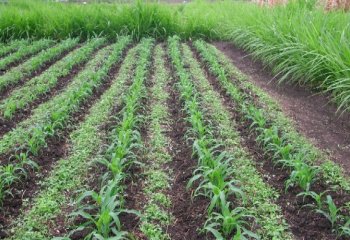
© icipe
legumes regulates pests (leafhopper, leaf beetles, stalk borer, and fall armyworm) and increases the land utility. Intercropping Canavalia (Canavalia spp.) with maize improves soil productivity. Sow Canavalia seeds 4 weeks after sowing maize. Place 1 seed/per hole in a row between maize rows with 50 cm between holes. Allow Canavalia to grow after harvesting maize until it is time to plant the next crop. Then plough the plant materials into the soil (CIAT, 2000).
Intercropping maize with beans and squash enhances parasitism of caterpillars. This practice increases food sources for beneficial insects whereby increasing abundance of natural enemies. The intercropping system of maize-beans-squash is a low input and high yield strategy in the tropics. Maize yield is increased by as much as 50% over monoculture yield. Although the yields for beans and squash are reduced, the overall yield for the 3 combined crops is greater than when grown separately in monocultures (Agroecology Research Group, 1996).
Push-pull Desmodium (Desmodium uncinatum) and molasses grass (Melinis minutifolia) when planted in between maize rows keep the stem borer moths away. These plants produce chemicals that repel stem borer moths. In addition desmodium supresses the parasitic witchweed Striga hermonthica. Napier grass (Pennisetum purpureum) and Sudan grass (Sorghum vulgare sudanese) are good trap crops for stem borers. Napier grass has its own defence mechanism against crop borers by producing a gum-like-substance inside its stem, this prevents larva from feeding and causing damage to the plant. Both grasses attract stemborer predators such as ants, earwigs, and spiders. Sudan grass also increases the efficiency of natural enemies, in particular parasitic wasps, when planted as border crops (Herren; Pickett, 2000; ICIPE, 2006). For more information on push-pull click here
h). Alternative uses of maize in mixed cropping
- Shading of vegetable crops by planting single rows between vegetables in areas of high intensity of sunshine can increase yields of intercropped vegetables.
- Use as support for runner beans for export or local consumption.
Harvesting and Post Harvest Management
Maize can be harvested by hand or by special maize combine harvesters. The stage of maturity can be recognised by yellowing of the leaves, yellow dry papery husks, and hard grains with a glossy surface. Maize is often left in the field until the moisture content of the grain has fallen to 15-20%, though this can lead to attack by grain borers in the covered cobs. In hand harvesting the cobs should be broken off with as little attached stalk as possible. They may be harvested with the husks still attached. These may be turned back and the cobs tied together and hung up to dry.
The world average yield in 2014 was 5,616 kg per hectare. Average yield in the USA was 10,732 kg per hectare, while in Africa it was 2,105 kg per hectare. Average yields in Kenya in 2014 was 18 bags/ha (1,660 kg/ha) (FAOSTAT, 2014).
Post Harvest Handling
The major problems in most maize-producing areas are reducing the moisture content of the grain to below 13%, protection from insects and rodents, and proper storage after harvest. High moisture content with high temperatures can cause considerable damage such as development of aflatoxin producing fungi, making the product unsuitable for human consumption.Maize for home consumption is either sun-dried on the cob for several days by hanging up tied husks, or put in a well-ventilated store or crib. Easy test for moisture content: take a few grains and try to crush them with your teeth - below 13% moisture level the grains are extremely hard and almost impossible to crush this way. Shelling (the removal of grains from the cob) is usually carried out by hand, though several hand and pedal-powered mechanical shellers are now available. The average recovery is about 75%. The shelled grain is dried again for a few days and then stored in bags, tins or baskets.
The optimum moisture content for storage is 12-13%. In Indonesia seed for the next crop is generally selected from the last harvest. The selected cobs are stored at home in the husk above the fireplace to prevent losses by insects. Crop residues are removed from the field and then used as fodder, fuel, etc.
Information on Pests
General information
Infestation and damage by pests have been ranked as the third most important constraint upon maize production in semi-arid eastern Kenya after moisture stress and poor soil fertility (Songa et al., 2002).
Stemborers and striga weed account for losses in maize in the eastern and southern Africa region of 15-40% and 20-100%, respectively. When they occur together, farmers can lose their entire crop (ICIPE, 2006). Earworms and armyworms are other major pests.
The principal pests of stored maize are Angoumois grain moth (Sitotroga cerealella), the larger grain borer (Prostephanus truncatus), maize weevils and rodents. More Information on Storage pests
Examples of Maize Pests and Organic Control Methods
| Fall armyworm (Spodoptera frugiperda) The fall army worm is larvae stage of fall army worm moth. It is a migratory pest native to America and was first reported in Africa in 2016. The army worm causes damage by feeding on leaves and stems of maize, rice, sorghum, sugarcane, vegetable and cotton. Fall army worm damages maize in all stages. In maize seedlings, it causes damage by feeding within the whorl. Larger larvae can cut the base of the plant. Mature plants suffer attack on reproductive structures. Symptoms of army worm damage in maize are a mass of holes on leaves and the whorl (funnel), ragged edges and larval frass. Young larvae skeletonize the leaf lamina. Severe feeding damage to young plants can kill the growing point; causing 'dead heart' in maize. Maize cobs are attacked by larvae boring through the kernels. At high densities, large larvae may act as armyworms and disperse in swarms, but they often remain in the locality on wild grasses, if available. What to do:
|
| Cutworms (Agrotis spp. and other species) Cutworms cut maize seedlings at or a little below ground level, make small holes along the initial leaves, or remove sections from the leaf margins.
What to do:
|
| Maize aphid or corn leaf aphid (Rhopalosiphum maidis) It is dark green to bluish-green in colour with black cornicles. Particularly during dry/periods the colonies appear on the inflorescences and young leaves. Feeding by this aphid causes yellow mottling, but this damage is seldom of economic importance. Their role as vector of the sugarcane virus, maize dwarf mosaic virus and maize leaf-fleck virus makes them a pest of considerable importance. This aphid usually attacks maize plants at the end of the mid-whorl stage. Aphid colonies may completely cover emerging tassels, and the surrounding leaves, preventing pollen release. In severe outbreaks the ear shoot is also infested, and seed set may be affected. What to do:
|
| Termites (Microtermes spp., Macrotermes spp., Allodontermes spp., and Odontotermes spp) Often referred to as "white ants", they occasionally cause partial or total defoliation of maize seedlings, but are mainly damaging to older maize plants. Severely damaged plants may lodge and be completely destroyed by termites. The longer a field has been cultivated, the greater will be the yield losses caused by termites. Their feeding inside the stems causes the plant to wither and sometimes die. Termites begin to attack the roots and stems about 3 months after planting, and eventually cover them with tunnels built of soil. As plants mature the amount of damage increases rapidly. Infestation is particularly serious in dry season. It has been established that termites can damage up to 25% of maize crops in Malawi (WISARD Project Information, 2001).
What to do:
|
| Several species of grasshoppers and locust feed on maize. The edible, a long horned grasshopper Homorocoryphus nitidulus vicinus (Ruspolia differens) has been reported to occasionally attack maize in Tanzania (Bohlen, 1973). This grasshopper attacks maize in the silking stage, arresting pollination. Other grasshoppers and locust attack maize from the mid-whorl stage to maturity, and may consume every part of the plants. Attacks vary in severity from location to location.
What to do:
|
| Larger grain borer (Prostephanus truncatus) and the grain weevils (Sitophylus spp.) They attack stored maize grains. Both the adults and the larvae (grubs) of these beetles feed in the grains. Adults come from infested cobs in the field or from an infested maize store and lay eggs in the grains. They attack maize both in the field and after harvest. Attacked maize grains lose all their contents and are not fit to eat. These pests become a serious problem in short time if no control measures are applied. The larger grain borer also attacks dried cassava roots and even the wooden structures of the stores.
What to do:
|
| Angoumois grain moth (Sitotroga cerealella) The larvae of the Angoumois grain moth penetrate and feed inside maize grain. This insect may also infest the crop in the field prior to harvest. The moths are small (nearly 1 cm long) yellowish or straw-coloured, a have a fringe along the posterior margins of the wings. They can be observed flying around infested stores. Female moths lay eggs at night. Eggs are laid singly or in clumps on the outside of cereal grains, in cracks, grooves or holes made by other insects. Eggs are initially white turning red near hatching. The larvae are whitish. The larvae prepare a round exit hole for the moth, leaving the outer seed wall only partially cut as a flap over the hole, resembling a trap door. The adult pushes its way out through this "window" leaving the trap door hinged to the grain. Infested grains can be recognised by the presence of these small windows. The adult lifespan may be up to 15 days, and 1 female can lay over 100 eggs.
What to do:
|
| They can damage maize from the seedling stage to maturity. The presence of small, faint yellow blotches on the lower leaves is an indication of spider mite injury. As the colonies of mites increase in size they cause the lower leaves to become dry. The mites then migrate to the upper leaves. In Africa several species of spider mites have been reported on maize (mainly Tetranychus spp. and Olygonichus spp.). In Kenya, they are occasionally found on maize, but usually they are not of economic importance.
What to do:
|
| White grubs are the larvae of scarab "chafer" beetles. They are white, C-shaped with a brown head and 3 pair of legs. Some species of whitegrubs (e.g. Phyllophaga spp, Heteronychus spp.) feed on roots of maize plants. Root damage is manifested by wilting seedlings, poor stands, and patches of tilted or lodged plants showing uneven growth. Injured plants can easily be pulled out of the ground.
Feeding of adults on maize leaves is usually not of economic importance. However, adults of the black maize beetles (Heteronychus spp.) are reported as major pests of cereals in many parts of Africa. They eat the stems of young shoots just below the ground. One adult beetle may destroy several seedlings in a row.
What to do:
|
| Stemborers: African maize stalkborer (Busseola fusca) Stemborers are the most important insect pests of maize in sub-Saharan Africa. Yield losses vary between 10-70%. Several species have been reported. The importance of a species varies between regions, within a country or even the same eco-region of neighbouring countries. At least four species attack maize in eastern and southern Africa, with yield losses reported to vary from 20 to 40%, depending on agroecological conditions, crop cultivars, agronomic practices and intensity of infestation.
The most important are the African maize stalkborer (Busseola fusca) and the spotted stemborer (Chilo partellus) (see also below).
The pink stalkborer (Sesamia calamistis) and the sugarcane stalkborer (Eldana saccharina) are of minor importance in maize.
Early warning signs: Young plants have pinholes in straight lines across the newest leaves. This is the time to treat - before the caterpillars move into the stem. What to do:
|
| Stemborers: Spotted stemborer (Chilo partellus) Stemborers are the most important insect pests of maize in sub-Saharan Africa. Yield losses vary between 10-70%. Several species have been reported. The importance of a species varies between regions, within a country or even the same eco-region of neighbouring countries. At least four species attack maize in eastern and southern Africa, with yield losses reported to vary from 20 to 40%, depending on agro-ecological conditions, crop cultivars, agronomic practices and intensity of infestation.
The most important are the African maize stalkborer (Busseola fusca) (see above) and the spotted stemborer (Chilo partellus). The pink stalkborer (Sesamia calamistis) and the sugarcane stalkborer (Eldana saccharina) are of minor importance in maize.
Early warning signs: Young plants have pinholes in straight lines across the newest leaves. This is the time to treat - before the caterpillars move into the stem. What to do:
|
| African bollworm (Helicoverpa armigera) Caterpillars of the African bollworm also known as the corn worm or earworm attack mainly the developing cobs, although they may occasionally feed in the leaf whorl or on tender tassels. Eggs are laid on the silks. Caterpillars invade the cobs and feed on developing grain. Development of secondary infections is common. Local outbreaks of this pest are sometimes severe.
What to do:
|
| African armyworm (Spodoptera exempta) The African armyworm is a very damaging pest, capable of destroying entire crops in a matter of weeks. Although they are regarded as occasional pests, in an outbreak large number of caterpillars will appear destroying the whole plant to ground level.
What to do:
|
| Maize ladybird beetle (Epilachna similes) The adult is oval in shape, about 6 mm in length and reddish brown in colour with black spots on the wing covers. The body is covered with short, light coloured hairs. The larvae are 7-9 mm in length, soft and covered with dark coloured spines. They pupate on leaves. Both larvae and adults of the maize ladybird beetle feed on leaves, scrapping them, usually on the underside, leaving the upper epidermis intact. This beetle will cause much damage only when present in large numbers. It also attacks cereals such as wheat and sorghum. The maize ladybird beetle rarely causes serious defoliation and therefore control is usually not necessary. What to do:
|
| Maize leafhoppers (Cicadulina spp.) The adults are about 3 mm long, slender and cream to pale yellow green in colour. These leafhoppers have two small black spots between the eyes and brown marks behind the eyes extending along the body. They have brown lines along the wings. They usually hop away when disturbed. The direct damage cause by maize leafhoppers by sucking plants is insignificant, but the indirect damage is high because they transmit the maize streak virus, a major disease of maize. Cicadulina mbila is the most important vector.
Control of the maize leafhoppers is difficult since they are very active, remain infectious for a long time and are very quick in transmitting the virus. What to do:
|
| Maize plant hopper (corn lantern fly) (Peregrinus maidis) It is 4-5 m long and greyish in colour. The transparent wings are about twice as long as the body and show marked dark-brown veins. It is commonly found in groups in the funnel of the plants, the whorl, leaf sheath or underside of leaves. This insect produces large quantities of honeydew. As a result, sooty mould is often evident near the sites of aggregation. Nymphs and adults are in close association with ants, which feed on the honeydew produced by this plant hopper. This plant hopper transmits the maize mosaic nucleorhabdovirus (MMV), maize stripe tenuivirus (MSpV), and maize line virus that can become a limiting factor in maize production.
What to do:
|
| The virus causes a white to yellowish streaking on the leaves. The streaks are very narrow, more or less broken and run parallel along the leaves. The virus is transmitted by leafhoppers (Cicadulina mbila and C. bipunctella zeae). Maize streak virus is a serious constraint to maize production in sub-Saharan Africa. The reduction in yields depends on the time of infection. Plants infected at early stage usually do not produce any cobs. Yield losses in East Africa vary between 33 and 55% under natural infection conditions. In Nigeria, 75-100% of maize plants can be infected at the end of the growing season. However, resistant varieties in these areas appear to withstand these epidemics (Anon., 1983). Sugarcane, sorghum, millet, wheat, barley, oats, rye and wild grasses can also be severely affected.
What to do:
|
| Small oval (egg-shaped) spots first appear as water-soaked areas. They are dark and greyish-green in colour, turning greenish tan. With age they get bigger and become cigar-shaped. After rains or heavy dews, spores develop abundantly on both surfaces of the spots, particularly at the centres, giving a dark-green, velvety look to the spots. The spots may join and form large areas, which may kill entire leaves. Heavily infected leaves appear dry as if affected by drought. The disease is favoured by heavy and frequent rains, high relative humidity (above 90%) and relatively low temperatures (20-25°C). Warm dry conditions check disease development.
What to do:
|
| Southern leaf blight Bipolaris maydis (Helminthosporium maydis / Cochliobolus heterostrophus) Symptoms first appear as small yellow dots that become elongated between veins. They later become brownish to creamy white in colour with reddish to purplish brown borders. Light brown leaf spots with a brown margin, at first elliptical, becoming rectangular, up to 25 mm long and 2 - 6 mm wide. The spots are at first restricted by the leaf veins, but later they may merge. Leaves dry out and die prematurely. Silks, portions of the husks and cobs may turn black. A black mould may develop on cobs. Disease development is promoted by prolonged wetness on foliage, extended dew, RH (97-100%) and relatively warm temperatures (24-35°C). Spread is by airborne spores; and the fungus is also seed-borne. Survival in soil occurs for up to 12 months. What to do:
|
| Grey leaf spot (Cercospora zeae-maydis Symptoms are similar to Southern leaf blight but the spots are much narrower. They are initially light brownish in colour, and with age they bleach to ashen grey surrounded by narrow light-brownish border. When wet, spore mass is formed on the spots with a light shade. This disease is favoured by prolonged periods of high relative humidity. It can cause yield losses of 30 to over 50%. What to do:
|
| It is recognised by the appearance of circular to elongate pustules scattered over both surfaces of the leaf. Pustules are powdery and cinnamon-brown in colour. They contain masses of spores (uredospores). Pustules can appear on any above-ground part of the plant, but they are most abundant on the leaves. With time the pustules split exposing the spores, which are spread by wind and initiate new infection. As maize matures, colour of spores in pustules change from reddish to black due to formation of teliospores (resting spores). The disease is spread by air transport.
What to do:
|
| Southern rust (Puccinia polysora) Symptoms resemble those of common rust, particularly in the uredial stage (urediospores). The cinnamon-brown pustules tend to be smaller and more circular in outline than those of common rust. Pustules of telial stage (teliospores) are chocolate brown to black and circular to elongate. They are distinguished from common rust by retention of the epidermis of the leaf over the pustule for a long time. No alternate host has been reported for Southern rust.
What to do:
|
| Common maize smut (Ustilago maydis) Characteristic symptom of common smut is formation of galls or tumuors on above-ground parts of maize plant. Galls frequently are from one to several centimetres in diameter. The galls are at first covered by a shining, whitish-green membrane. As the gall enlarges, the membrane ruptures, exposing a powdery black mass of spores.
What to do:
|
| Head smut (Sphacelotheca reiliana) The first symptoms become evident when tassels and cobs (ears) appear. These parts may be completely or partly converted into smut galls. Smut galls are initially covered by a delicate membrane that breaks open and exposes a mass of reddish-brown to black spores and strands of vascular tissue. The strands or fibres in the galls distinguish this disease from common smut. Head smut is seed-borne.
What to do:
|
| Ear rots (Gibberella zeae / G. fujikuroi) Characteristic symptoms include pink to brick-red colour on ears, husks and kernels. The fungi often gain entrance to the ears through channels made by earworms and borers. Bird damage to the ears also facilitates disease infection.
Symptoms Roots: dry rot. Seedlings: blight and subsequent death of the seedling. Leaves: leaves become a dull green colour when rots and stalks are infected early. Stalks: lesions are a dark brown to black colour in which black perithecia may be produced near the lower nodes. The pith is shredded and is pink to red in colouration. Ears: the fungus infects the ear via the silk channel and causes a red rot of the kernels from the tip of the ear. This may spread over the whole ear. What to do:
|
| A serious new disease of maize appeared in the farmers' fields in eastern Africa in 2011. Called maize lethal necrosis (MLN; or corn lethal necrosis, CLN), it can devastate maize crops. Infection rates and damage can be very high, seriously affecting yields and sometimes causing complete loss of the crop. The disease is difficult to control for two reasons: 1.It is caused by a combination of two viruses that are difficult to differentiate individually based on visual symptoms. 2.The insects that transmit the disease-causing viruses may be carried by wind over long distances. MLND is mainly spread by a vector, transmitting the disease from plant to plant and field to field. The most common vectors are maize thrips, rootworms, leaf beetles and aphids. Hot spots appear to be places where maize is being grown continuously. In Africa, the disease was first reported in Kenya, (South Rift Valley - Bomet and Naivasha districts) in September 2011 although its extent at that point suggested that the disease has been present for some time. According to the Kenyan Ministry of Agriculture, two percent of the maize harvest was affected in 2012. MLND has also spread rapidly into Tanzania, Uganda and South Sudan in the meantime. National and global research and extension organizations, laboratories, and seed companies are working together to control the spread of the disease and to develop and deploy disease-resistant maize varieties for the farmers as soon as possible.
For more information click here Cimmyt website
What to do:
Prevention:
Control:
|
| Couch grass or Bermuda grass (Cynodon dactylon) It is a spreading perennial grass with vigorous mat-forming stolons. It reproduces and spreads mostly by means of rhizomes but also propagates by seed. This grass is considered as one of the most important weeds in the world. It is present in virtually every tropical and subtropical country and in virtually every crop in those countries. Couch grass and other species of Cynodon are common in East Africa, and some species are occasionally troublesome as a weed of arable land and perennial crops. Couch grass is reported in Ghana as a problem in crops such as eggplant, okra, onion, peppers and tomato.
What to do:
|
| Purple witchweed (Striga spp.) The parasitic weeds Striga spp. known as witchweeds, are important pests of maize, particularly in drier areas. The weeds grow on the roots of maize affecting development of maize plants. The young weeds tap the roots of maize plant and draw water and nutrients. A single weed plant produces many thousands of tiny seeds that survive in the soil for long periods. A heavy infestation can cause complete yield loss.
Striga weeds infest 40% of the arable land in the savannah region, causing annual crop losses of 7 to 13 billion dollars. Around the Lake Victoria basin infestation by Striga hermonthica causes 30 to 100% loss in maize yield. Striga infestation is associated with increased cropping intensity and declining soil fertility. Witchweed infestation has resulted in the abandonment of much arable land by farmers in Africa. The problem is more serious in areas with low soil fertility and rainfall. None of these methods described will, alone, provide complete control and without complete control there is the certainty that surviving plants will mature and replenish the soil seed bank. Therefore, integration of one or more methods is essential for any substantial reduction of the problem. Furthermore, such integrated treatments will almost certainly need to be repeated over a number of years for long-term control.
What to do:
|
| Satintail (Imperata cylindrica) In south-western Nigeria, satintail is a major weed reducing maize yields. The rhizomes of this weed often reduce the efficacy of farmers' weed control practice (slashing followed by 2-4 times of additional weeding) and contribute to high yield losses.
What to do:
|
Information Source Links
- AIC, Kenya (2002). Field Crops Technical Handbook.
- Agroecology Research Group. Corn-bean-squash intercrop in Mexico. www.ag-transition.org
- Asean IPM Knowledge Network Management. Management of corn plant hoppers in the Philippines.
- Borgemeister, C., Holst, N., Hodges, R. J. (2003). Biological control and other pest management options fo larger grain borer Prostephanus truncatus. In Biological Control in IPM Systems in Africa. Neuenschwander, P., Borgemeister, C and Langewald. J. (Editors). CABI Publishing in association with the ACP-EU Technical Centre for Agricultural and Rural Cooperation (CTA) and the Swiss Agency for Development and Cooperation (SDC). pp. 311-328. ISBN: 0-85199-639-6.
- CAB International (2005). Crop Protection Compendium, 2005 Edition. Wallingford, UK www.cabi.org
- Dlib Magazine 2002 Vol 8 Number 5 www.anu.edu.au
- FADINAP. Integrated plant nutrition systems. www.eldis.org
- FAOSTAT, 2017 www.faostat.org
- Frescho seeds www.freshcoseeds.co.ke
- Herren, H., Pickett, J. (2000). Kenya: Vuta-sukuma (Push-pull) pest management in smallholder systems. ICIPE annual reports.
- ICIPE (2003). Development of biocontrol-based management of Helicoverpa armigera in eastern and southern Africa. 2000-2003 ICIPE Scientific Report. International Center for Insect Physiology and Entomology, Nairobi, Kenya. www.push-pull.net
- ICIPE. Implementation of habitat management strategies for the control of the stemborers and striga in maize-based farming systems in Eastern Africa and mechanisms of striga suppression by Desmodium sp. www.push-pull.net
- Intergrated management of the Fall Armyworm in maize. A guide for Farmer Field Schools in Africa, FAO 2018. www.fao.org
- IITA. www.iita.org
- Kranz, J., Schumutterer, H., Koch, W. (1977). Diseases, pests and weeds in tropical crops. Verlag Paul Parey. ISBN: 3-489-68626-8.
- Le Pelley, R. H. (1959). Agricultural insects of East Africa. East African High Commission. Nairobi, Kenya.
- Ministry of Agriculture 2006: Economic Review of Agriculture
- Nutrition Data www.nutritiondata.com.
- OISAT: Organisation for Non-Chemical Pest Management in the Tropics www.oisat.org
- Ortega, A. O. (1987). Insect pests of maize. A guide for field identification. Mexico, D. F.: CIMMYT. ISBN 968-6127-07-0
- Songa J.M., Overholt W.A., Mueke J.M., Okello R.O., (2002). Farmers' perceptions of aspects of maize production systems and pests in semi-arid eastern Kenya: factors influencing occurrence and control of stem borers. International Journal of Pest Management, 48 (1):1-11.
- Terry, P. J. and Michieka, R. W. (1987). Common weeds of Africa. Food and Agriculture Organization of the United Nations (FAO). ISBN 92-5-002426-6.
- CIMMYT Maize Program (2004). Maize diseases: A guide for field identification. 4th edition. Mexico, D. F: CIMMYT. ISBN 970-648-109-5
- The Organic Farmer Magazine
- Western seed company www.westernseedcompany.com
- WISARD PROJECT INFORMATION (2001). Biology and management of termites and white grubs in smallholder cropping systems.
- Youdeowei, A. (2002). Integrated pest management practices for the production of cereal and pulses. Ministry of Agriculture (MOFA) Plant Protection and Regulatory Services Directorate (PPRSD), Ghana, and the German Development Cooperation (GTZ). ISBN: 9988-0-1086-9.

